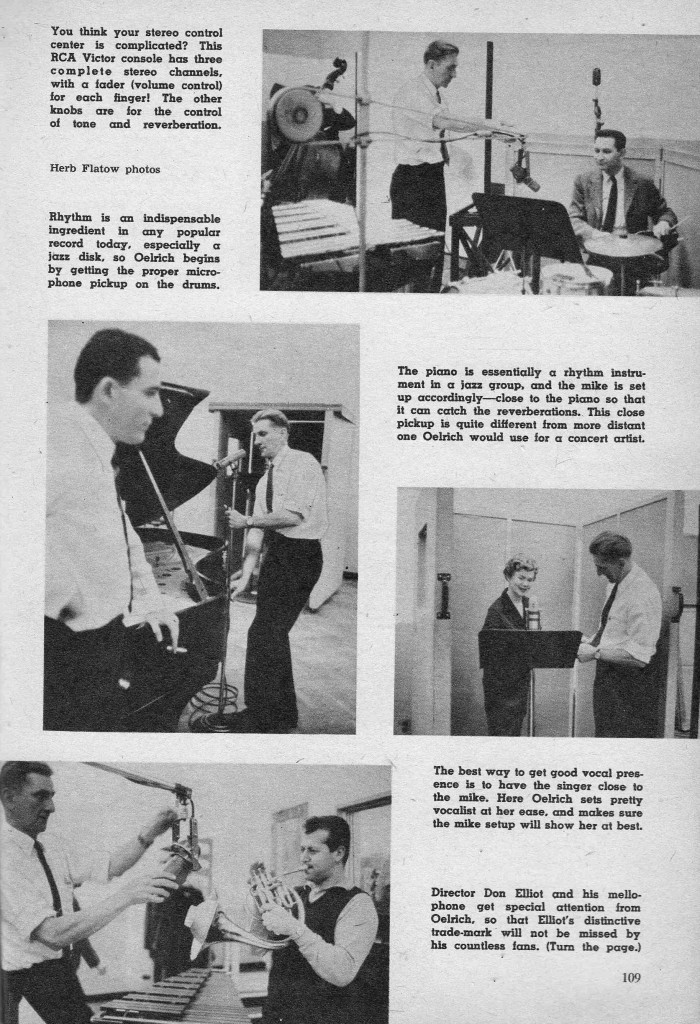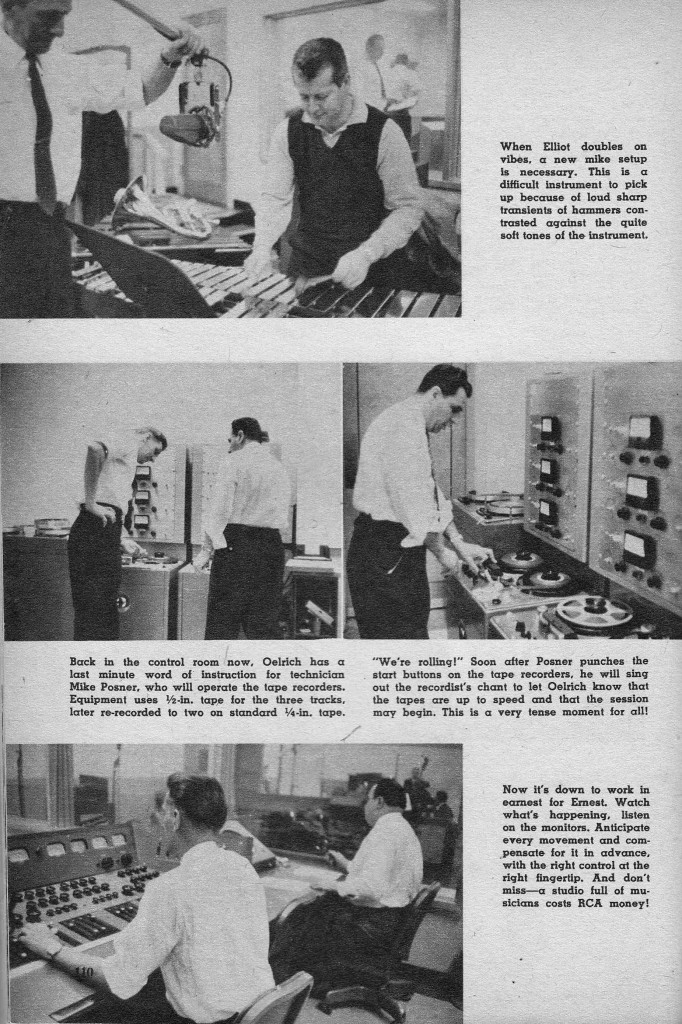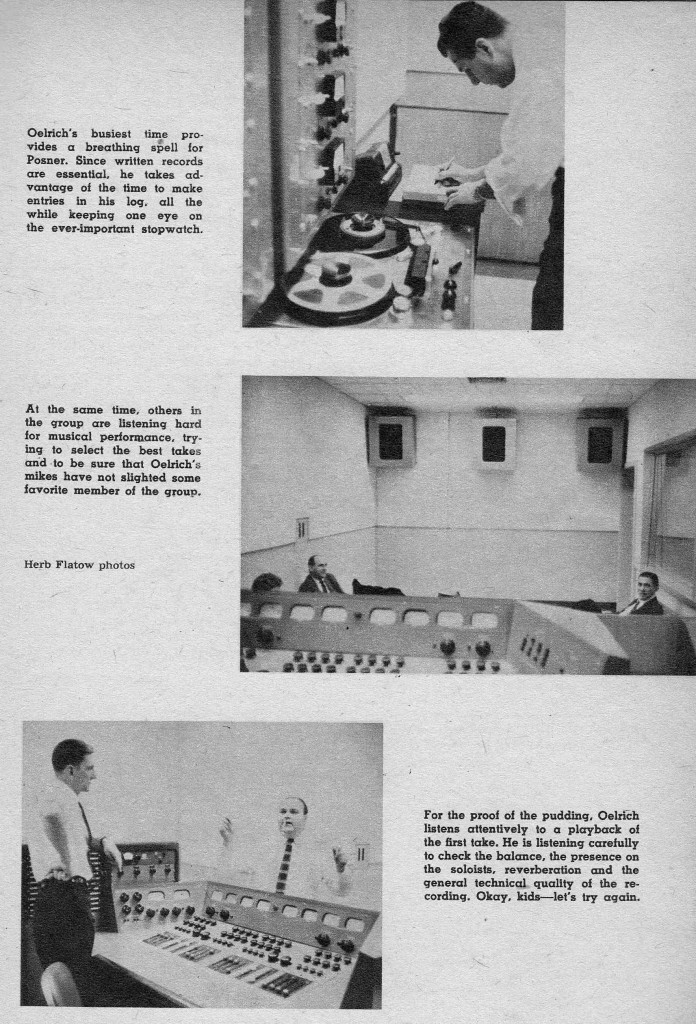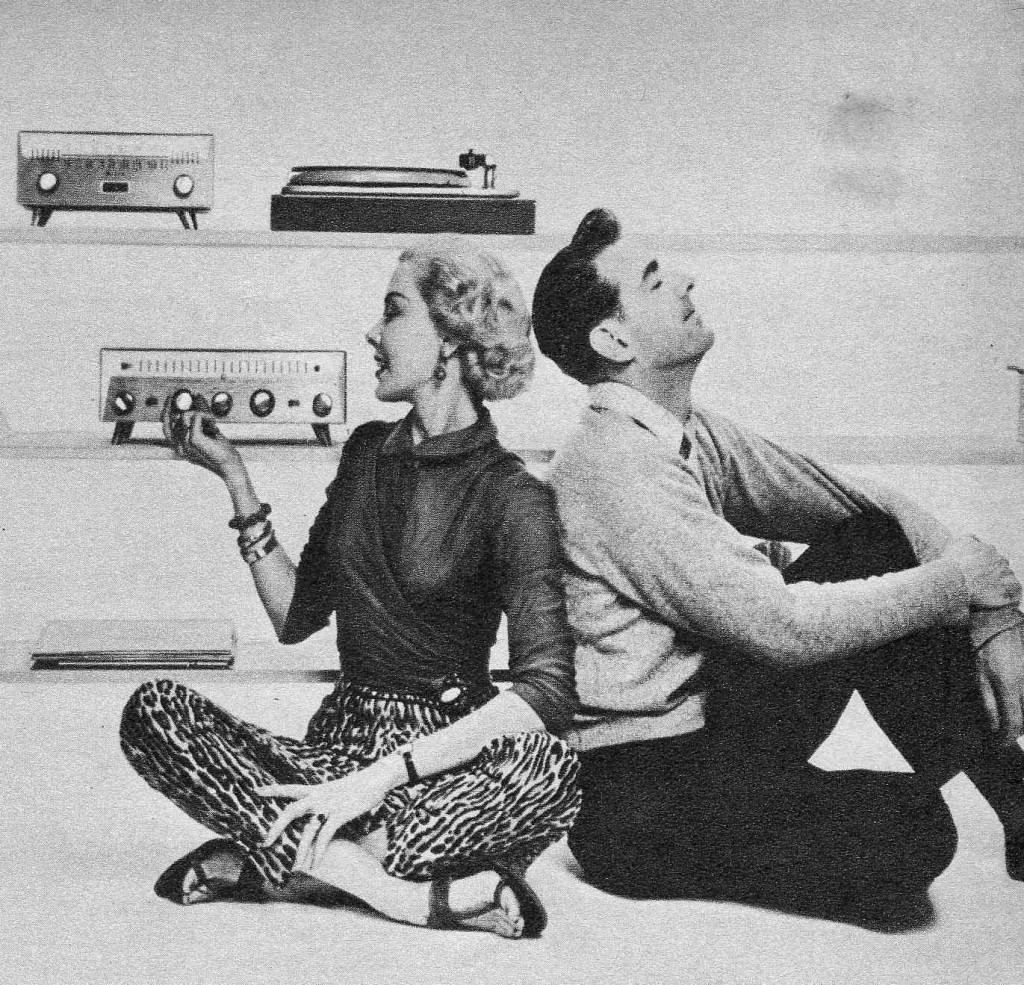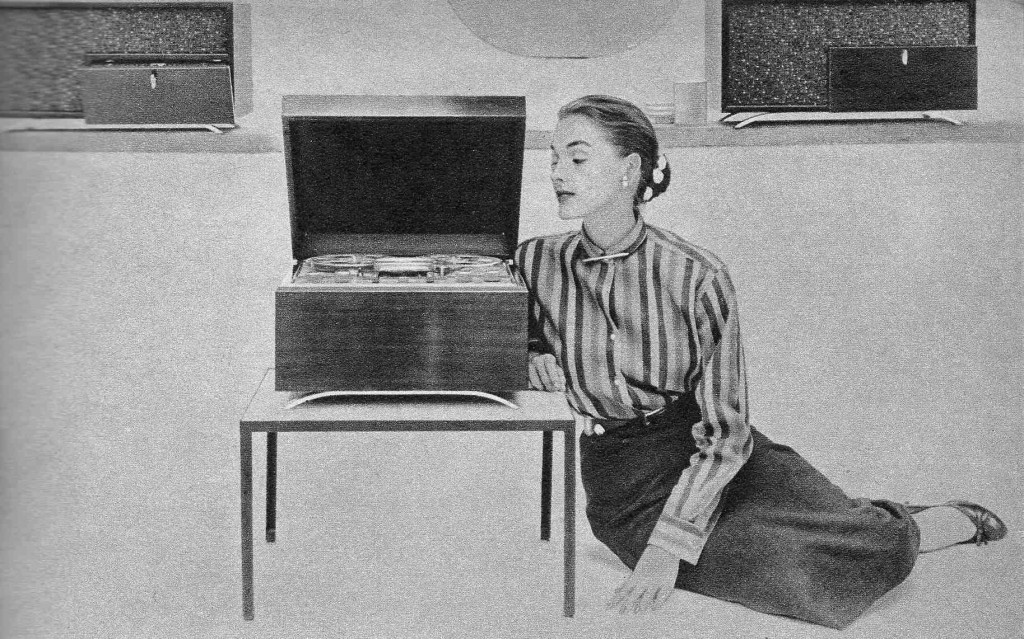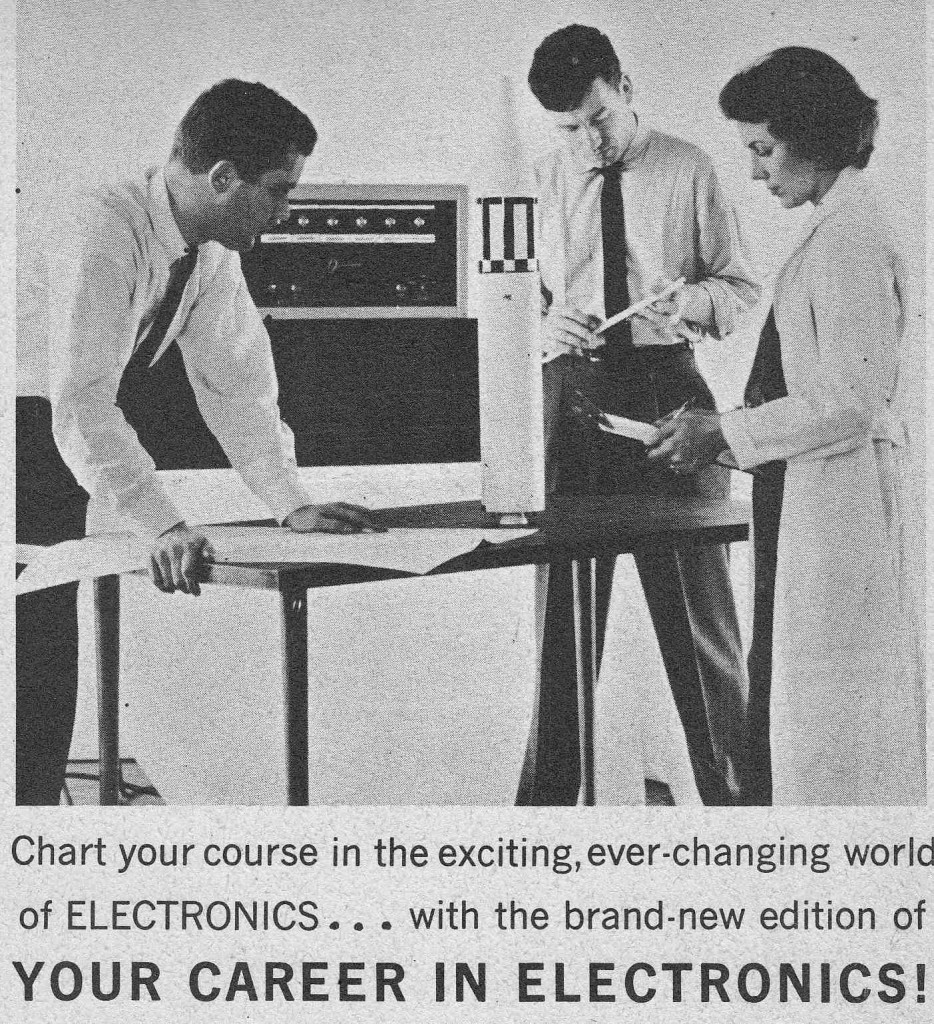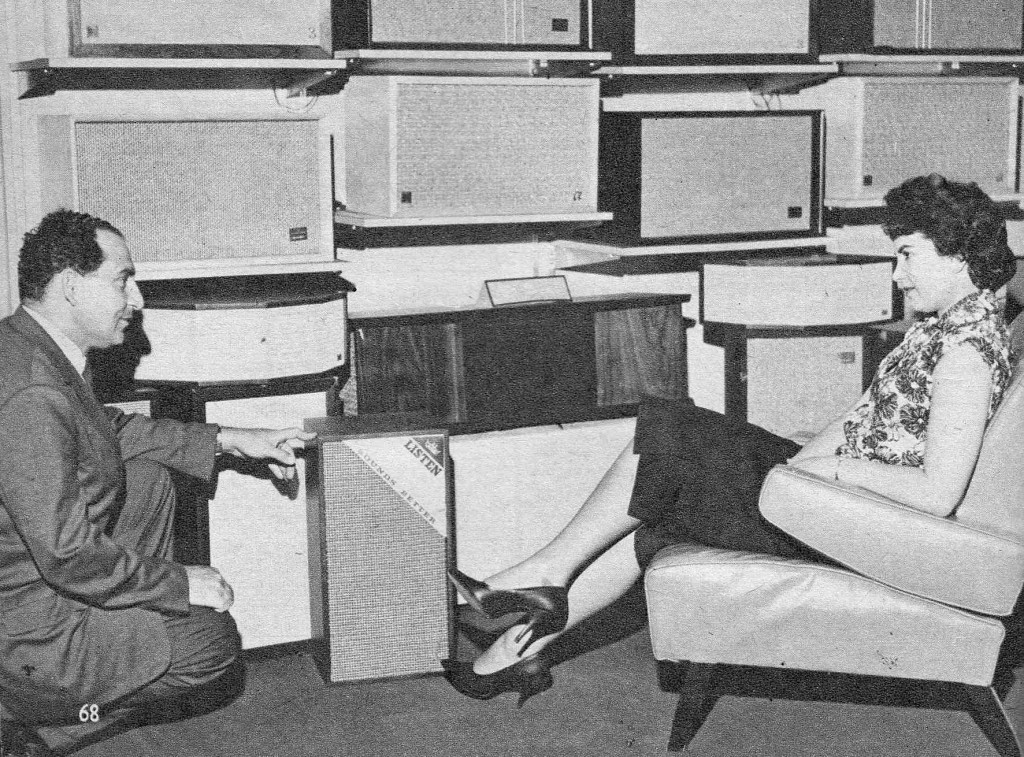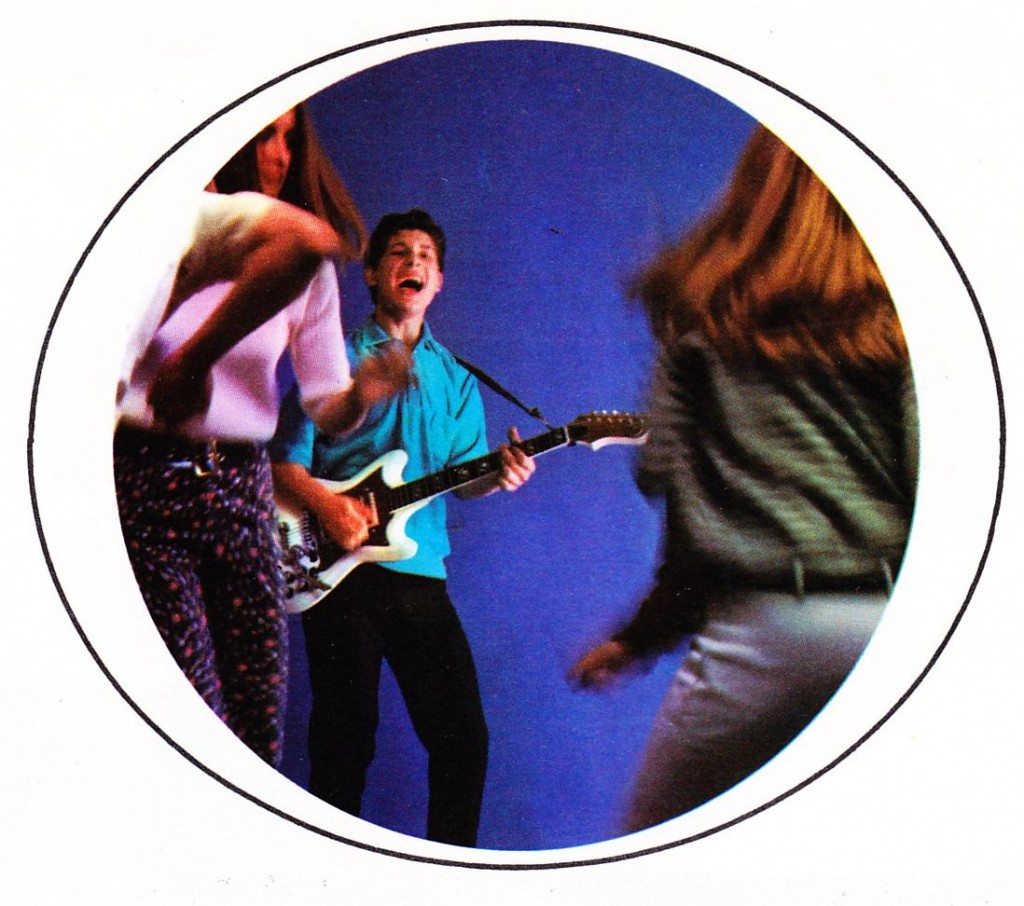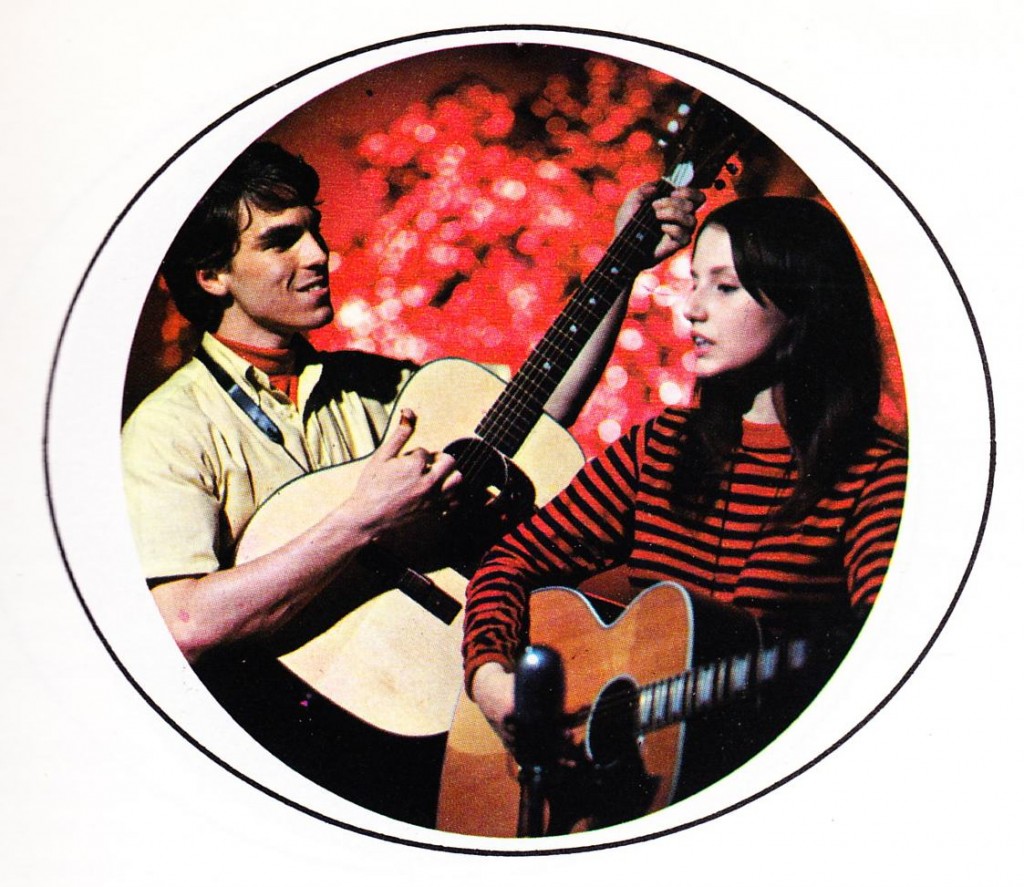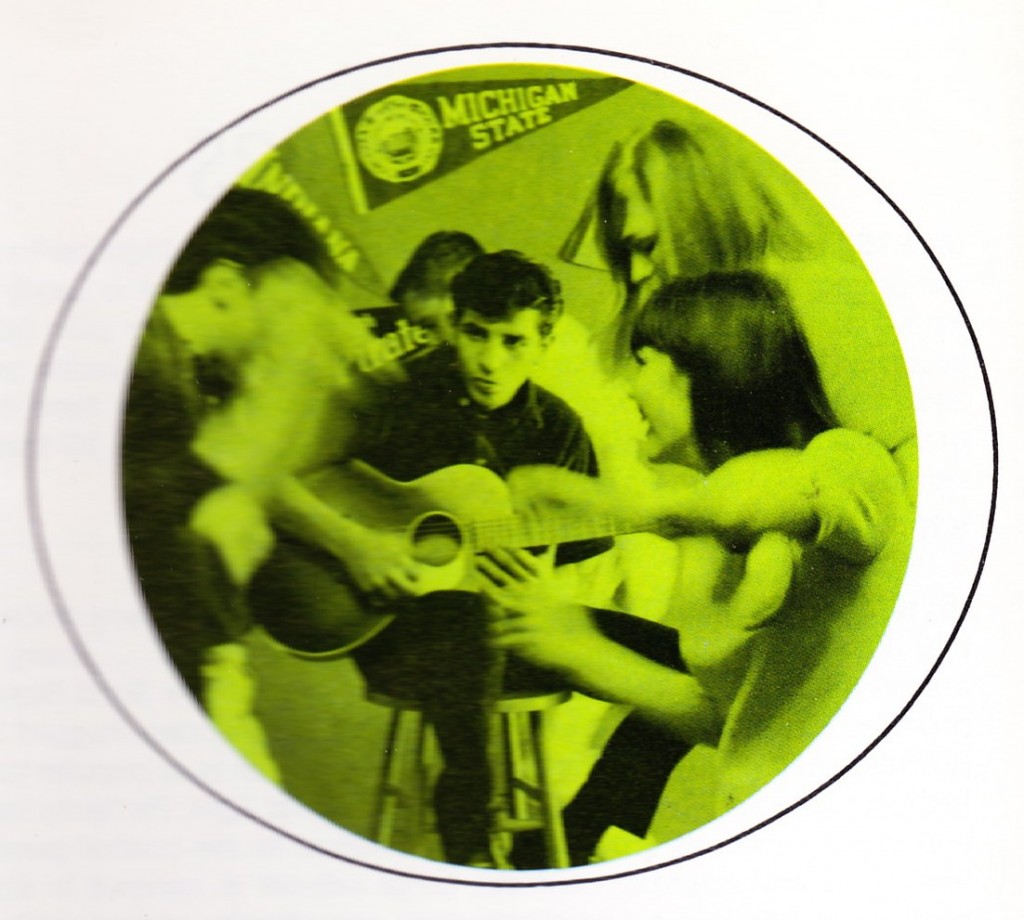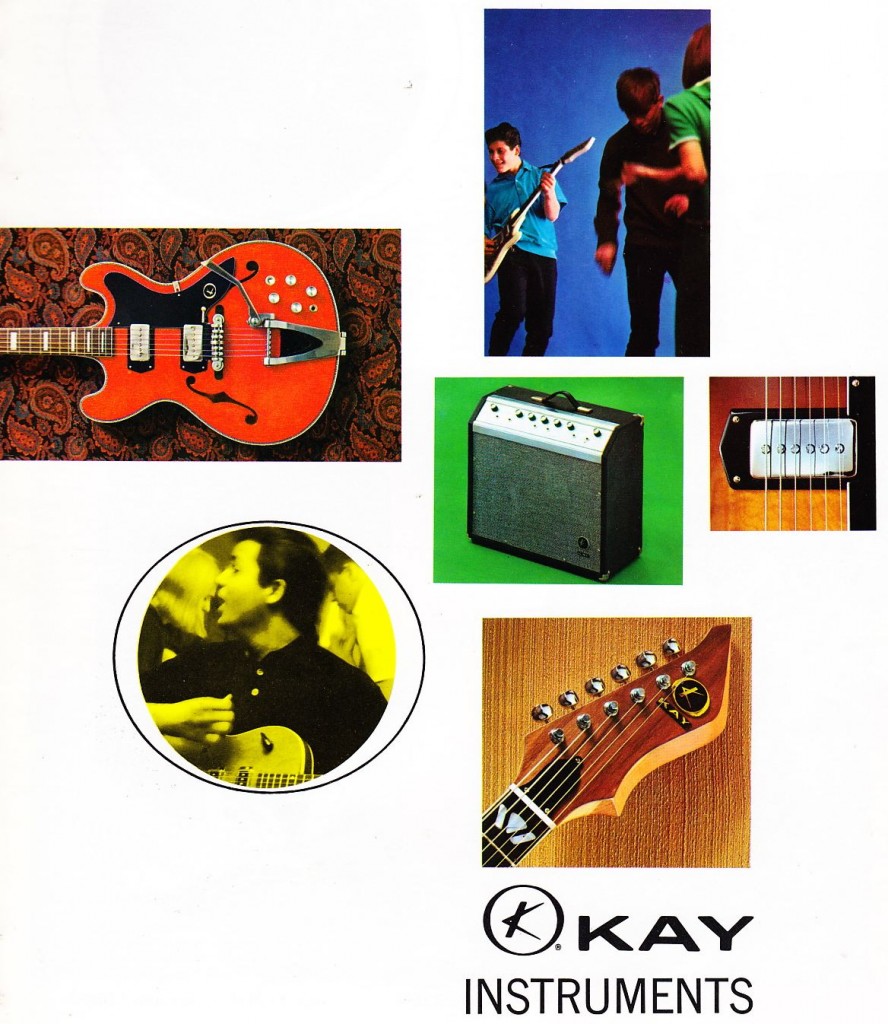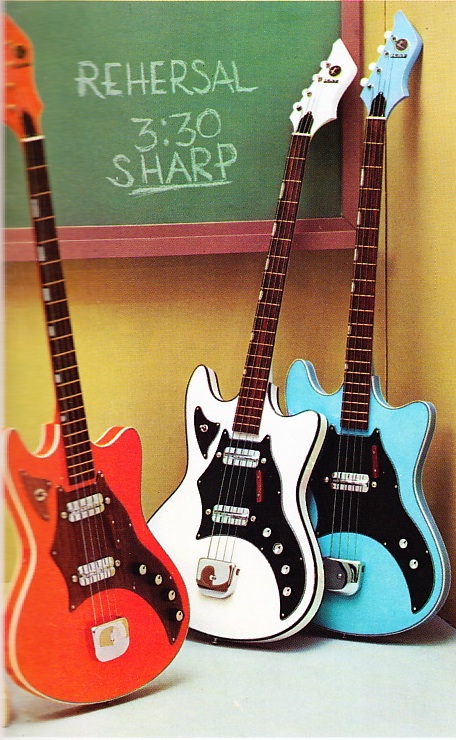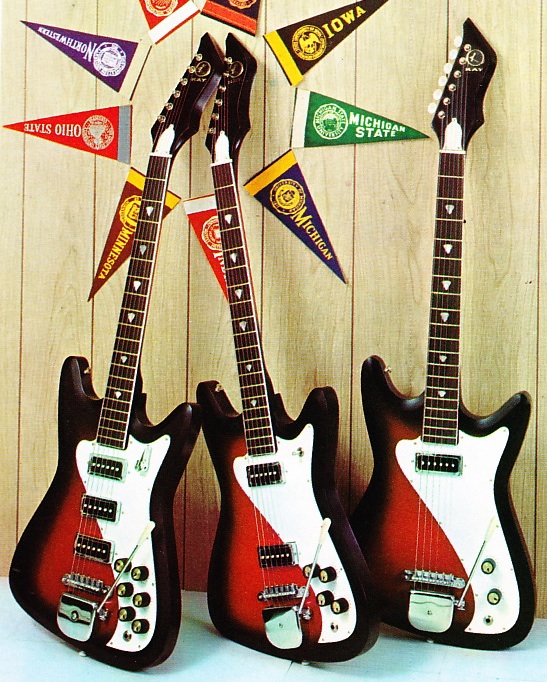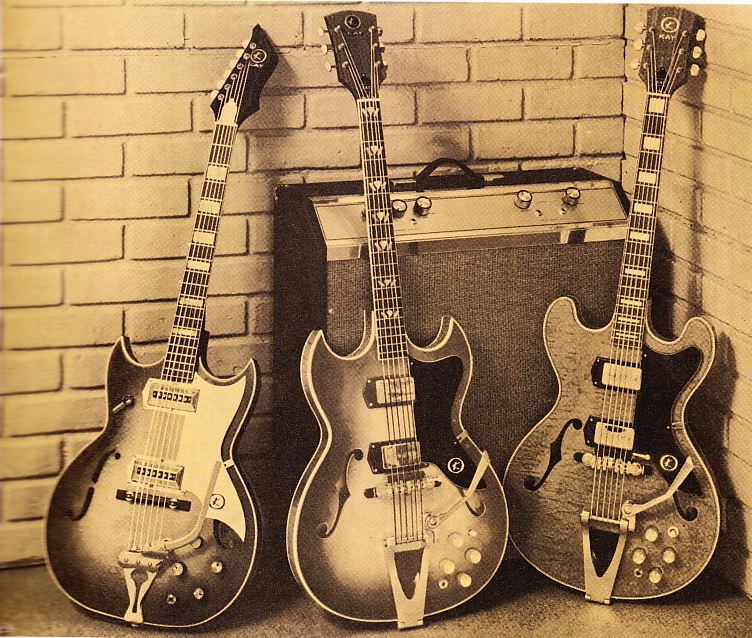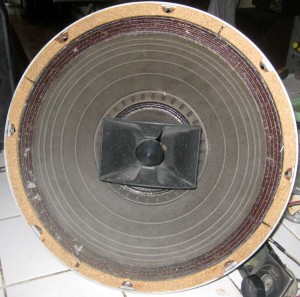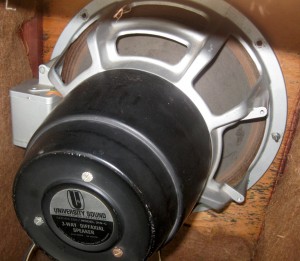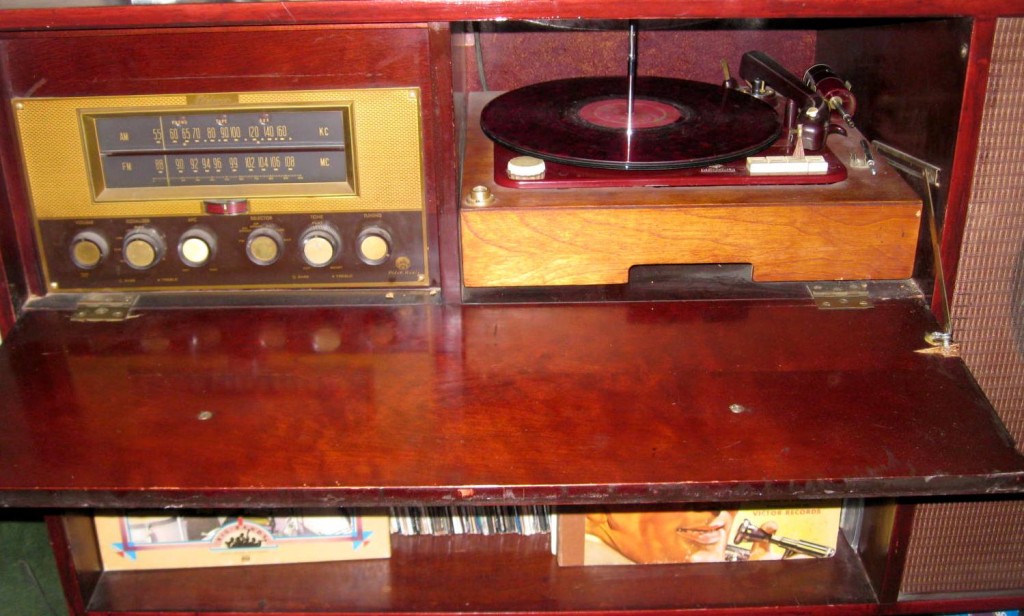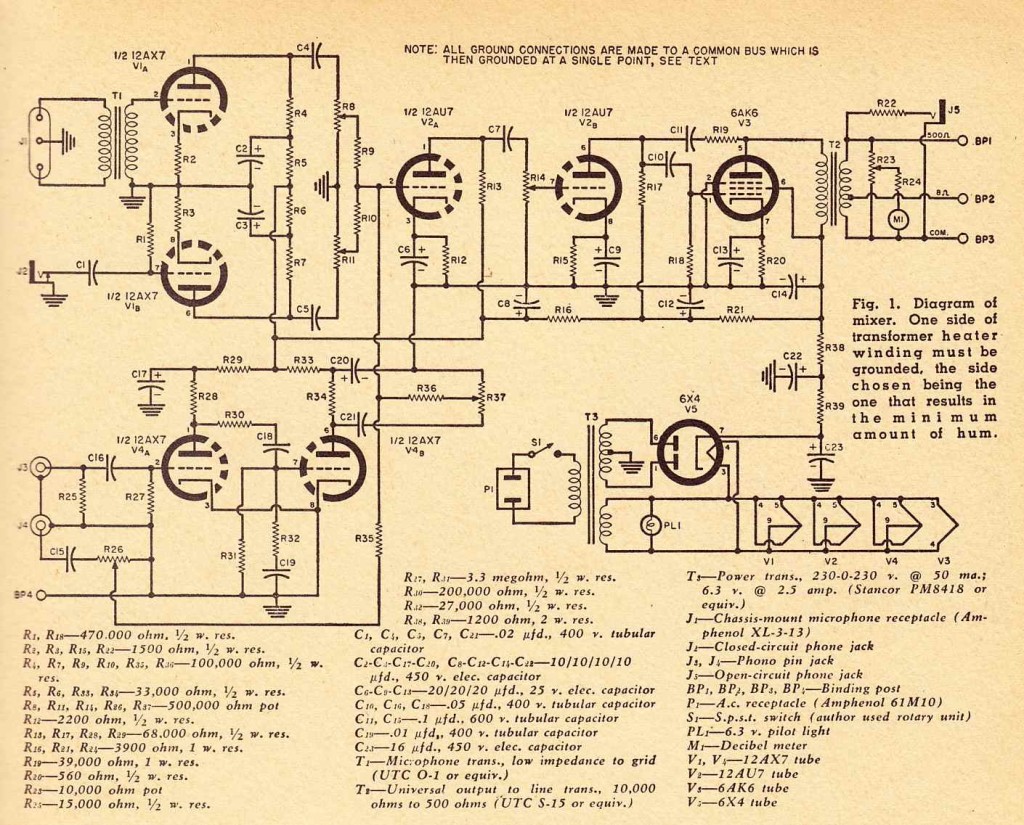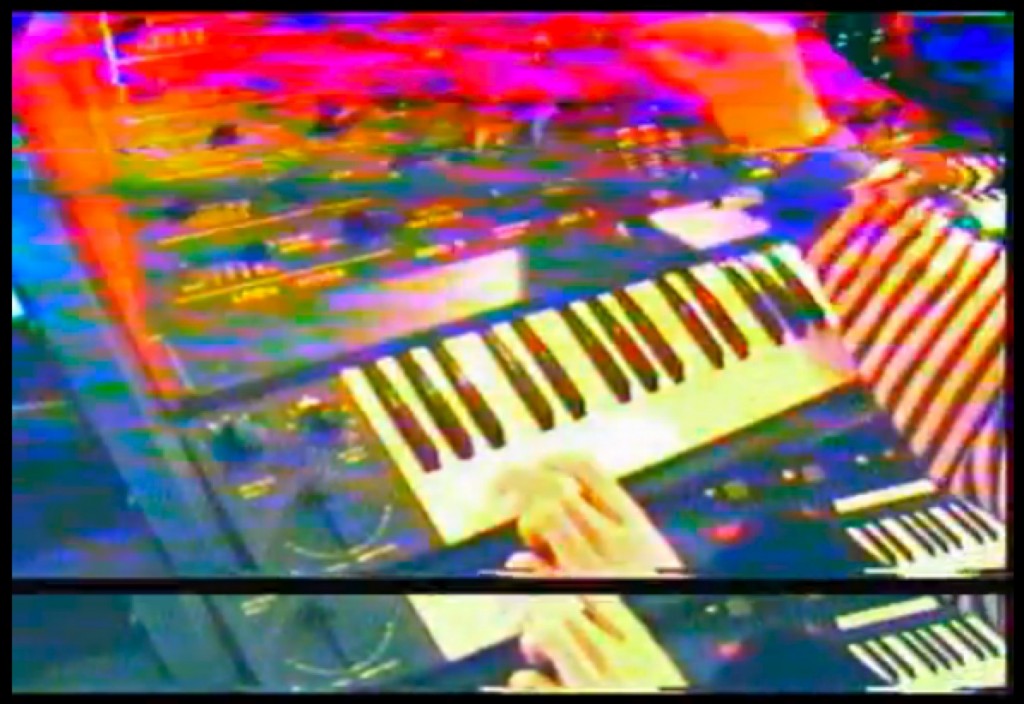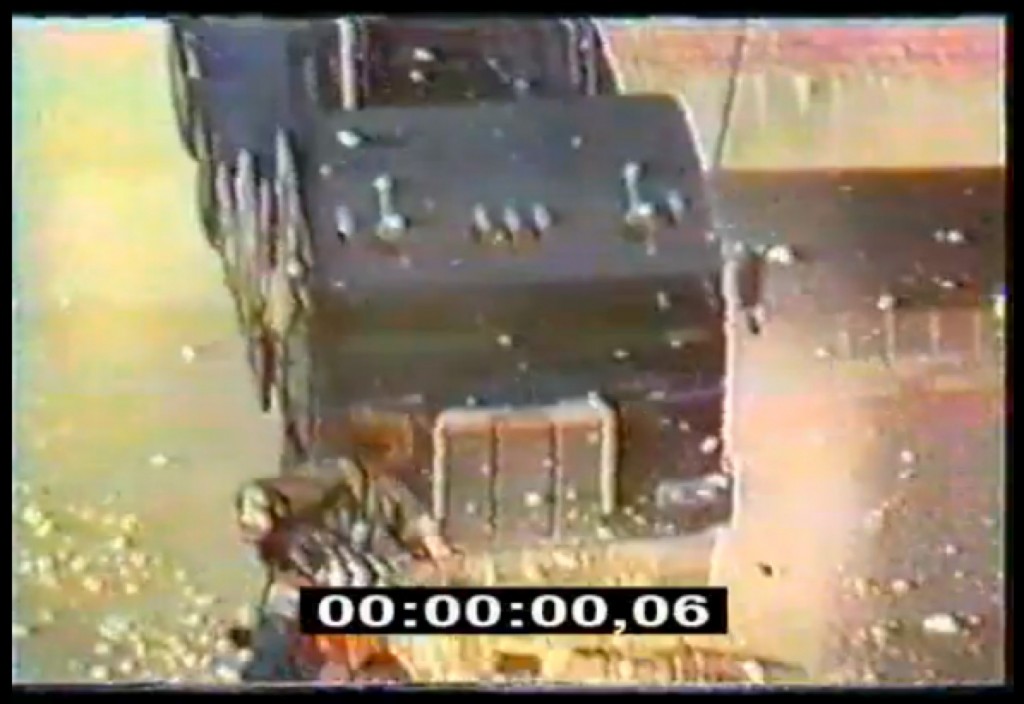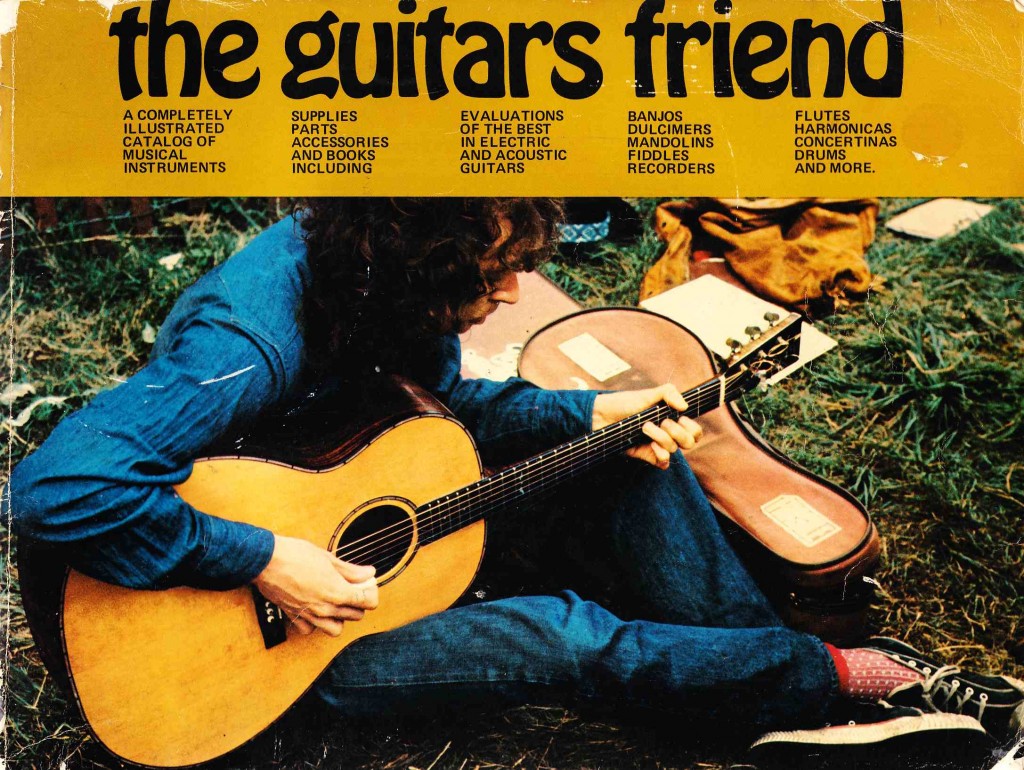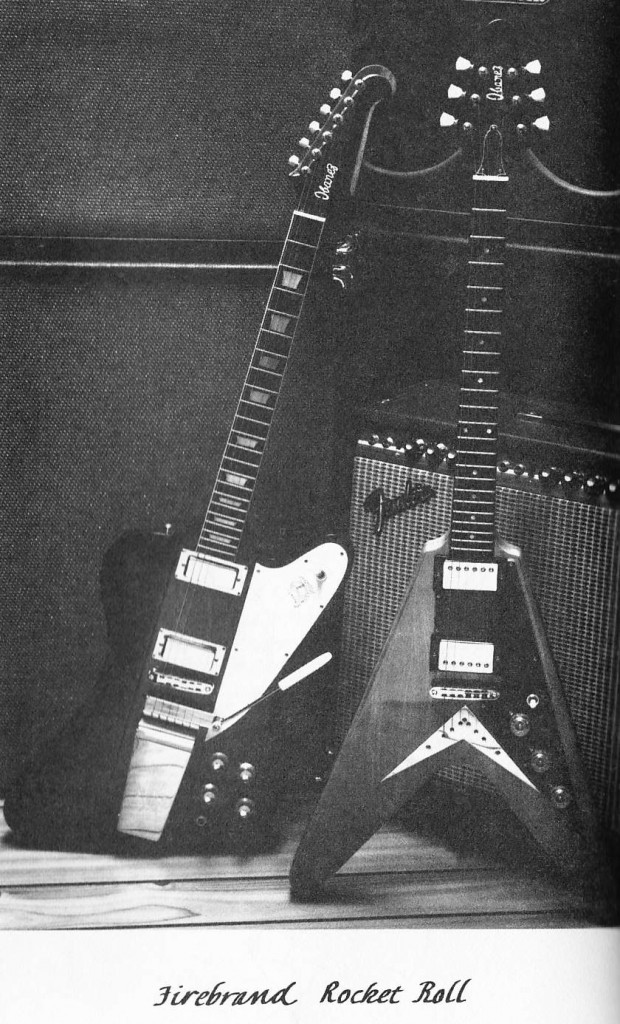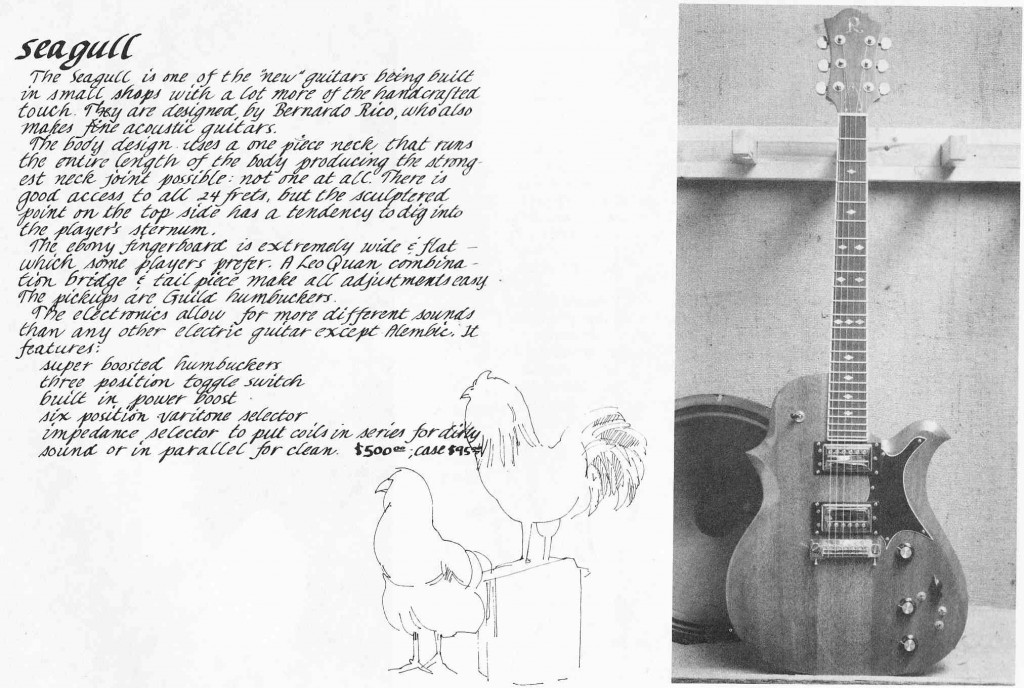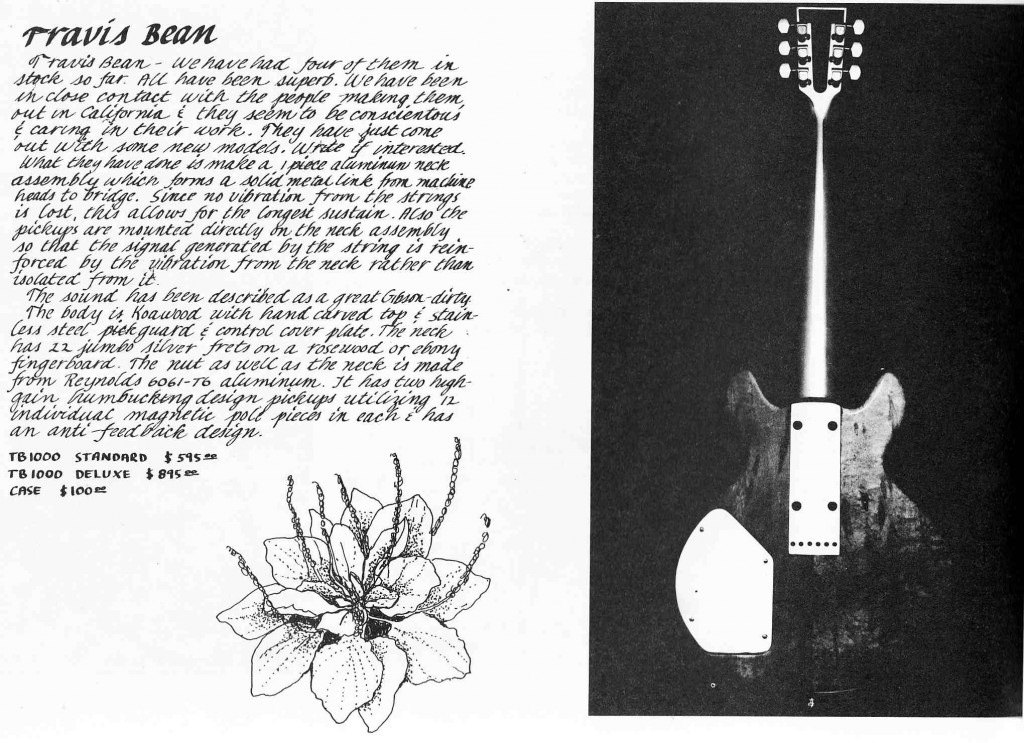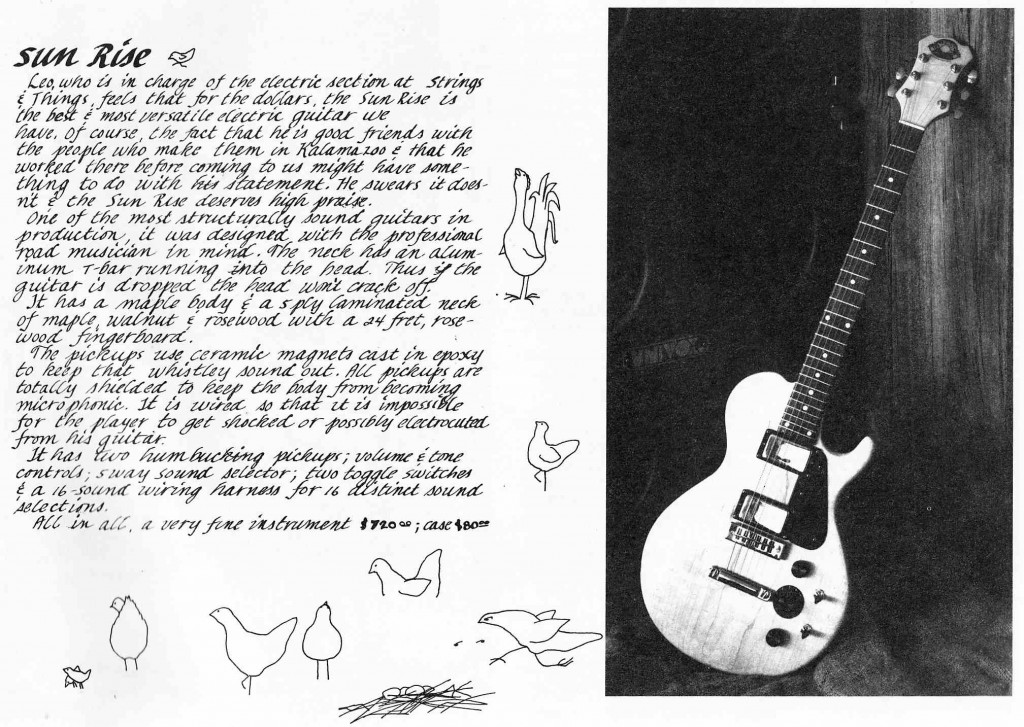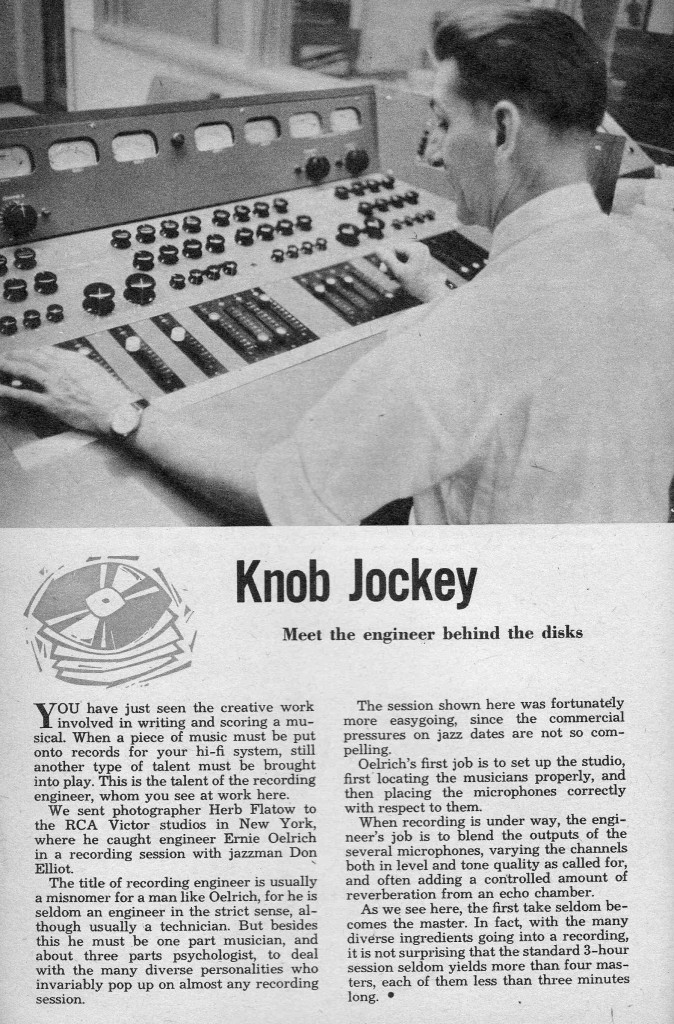 Four-page article from the popular press circa 1960 which claims to describe the work of a recording engineer of the day. “Three complete stereo channels with a fader for each finger!”
Four-page article from the popular press circa 1960 which claims to describe the work of a recording engineer of the day. “Three complete stereo channels with a fader for each finger!”
 Images of women as depicted in high-fidelity guidebooks circa 1960. These sort of publications generally deal in DIY advice, schematics, and ‘buyers guide’ segments. There is a lot of floor-sitting, demure outfits, and distant-gazing. There is an uncanny similarity to many of these photographs. Or as E puts it: ‘WTF. They all look like cats.’ Yeah that pretty much says it.
Images of women as depicted in high-fidelity guidebooks circa 1960. These sort of publications generally deal in DIY advice, schematics, and ‘buyers guide’ segments. There is a lot of floor-sitting, demure outfits, and distant-gazing. There is an uncanny similarity to many of these photographs. Or as E puts it: ‘WTF. They all look like cats.’ Yeah that pretty much says it.
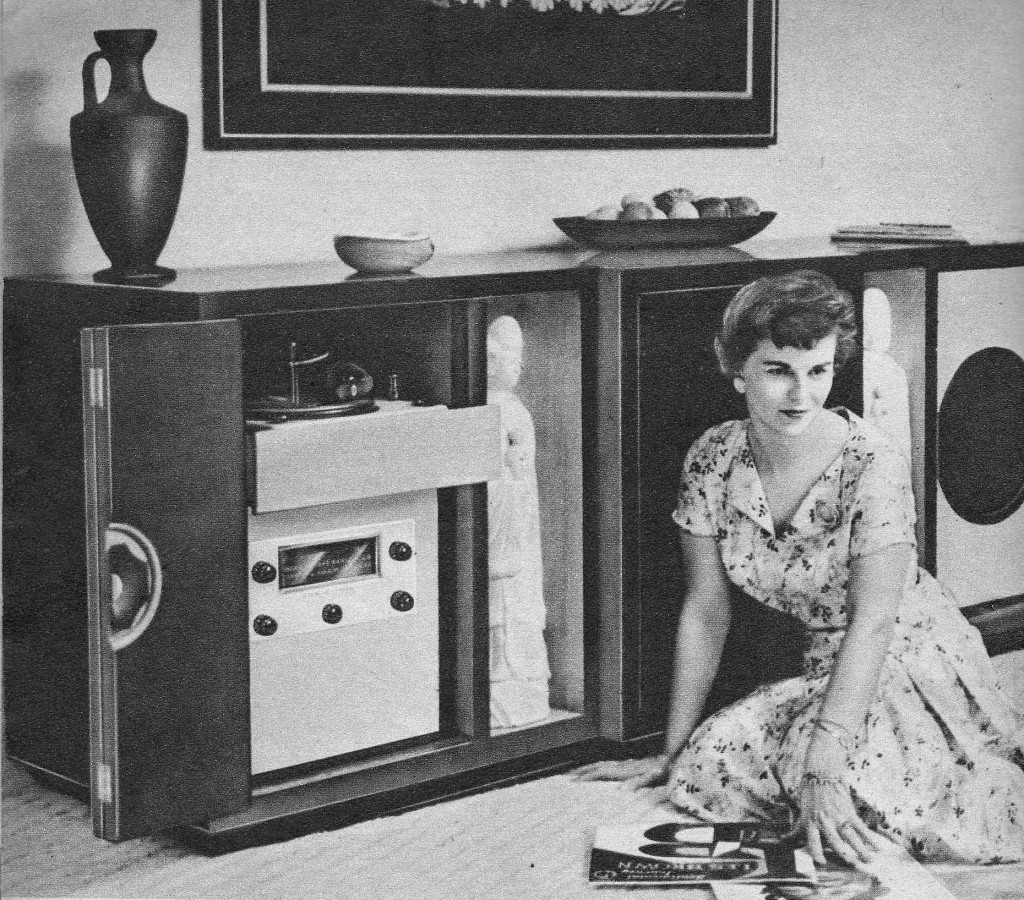
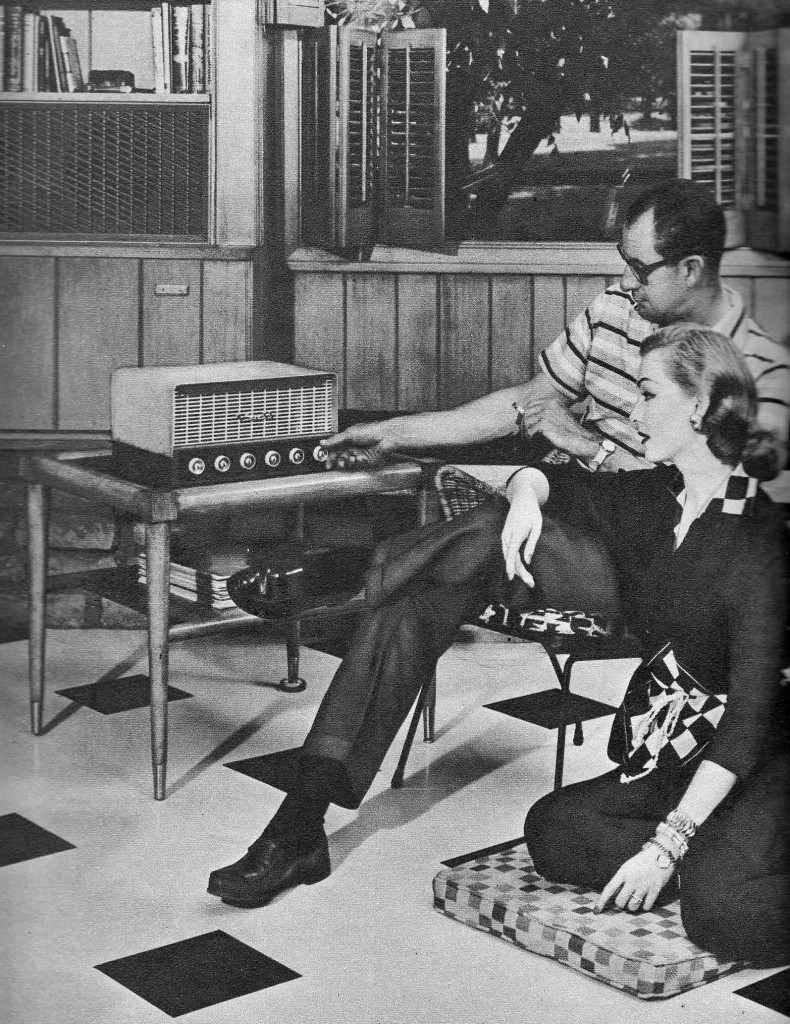
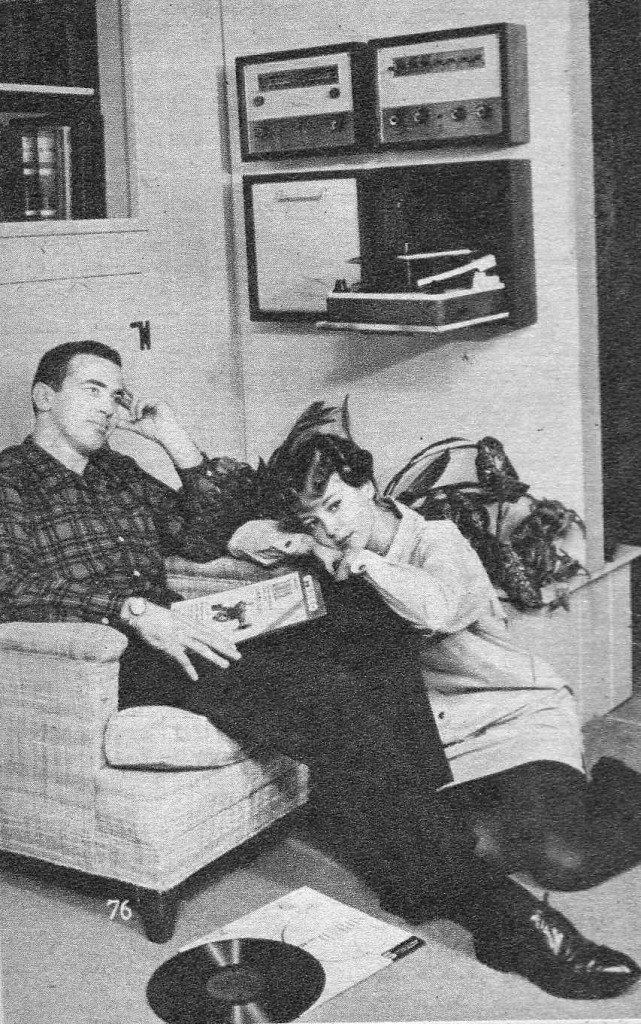
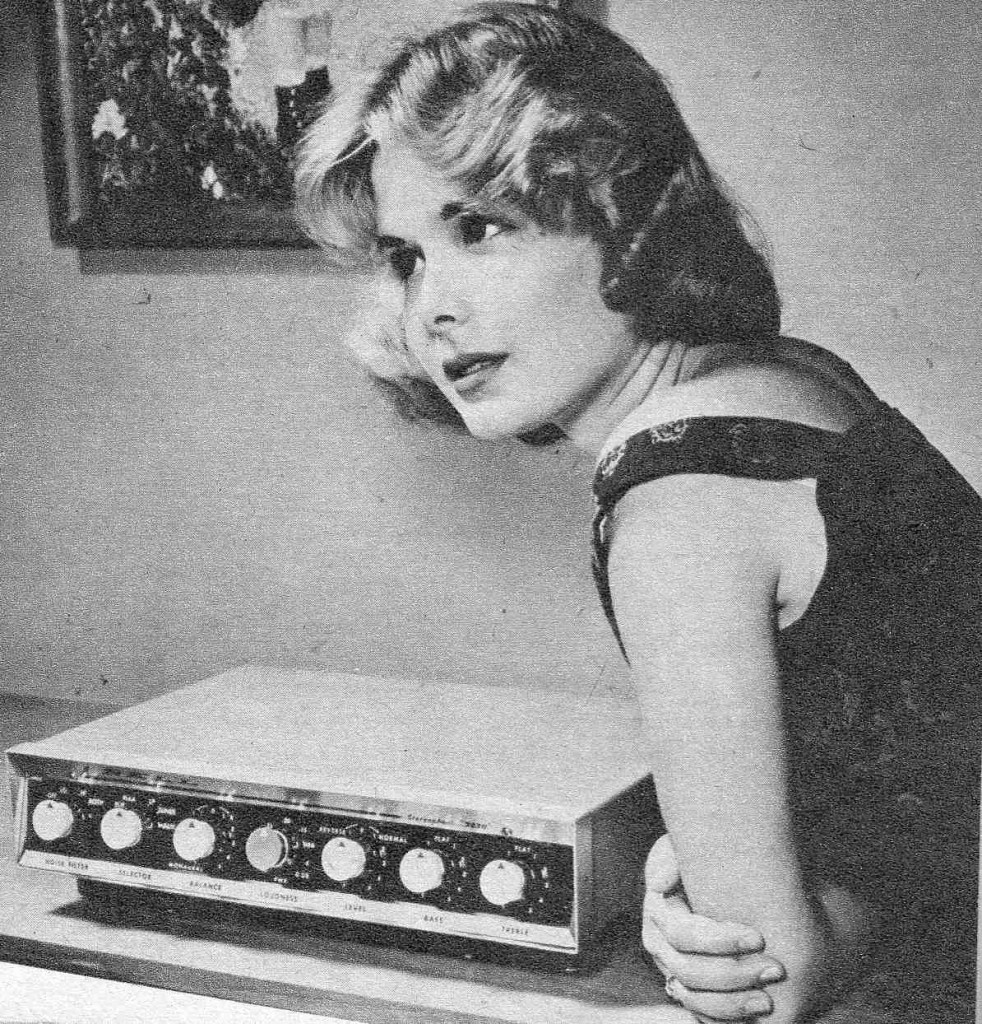
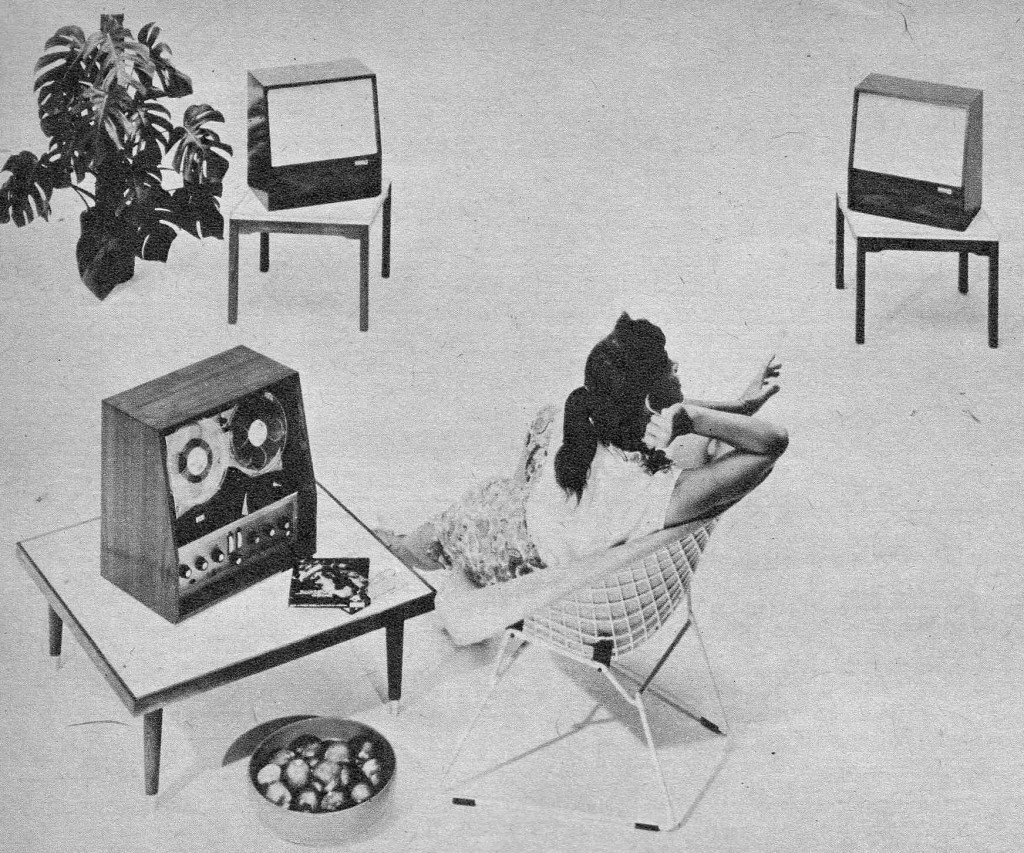
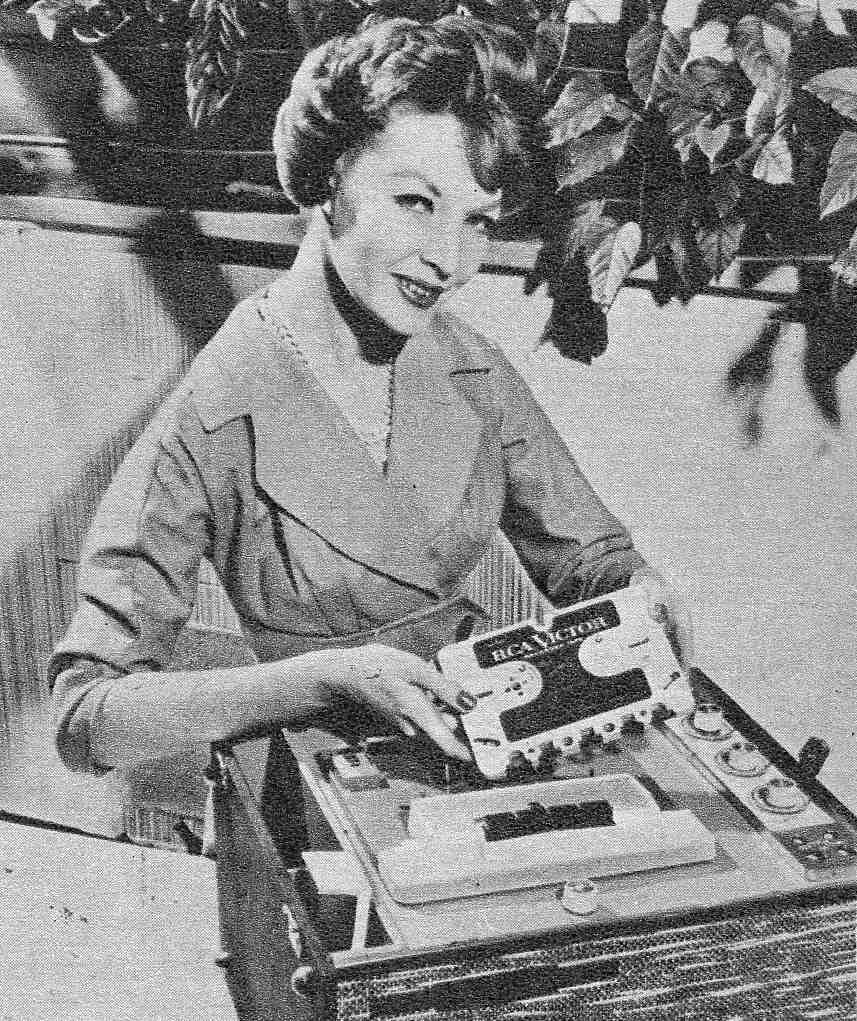
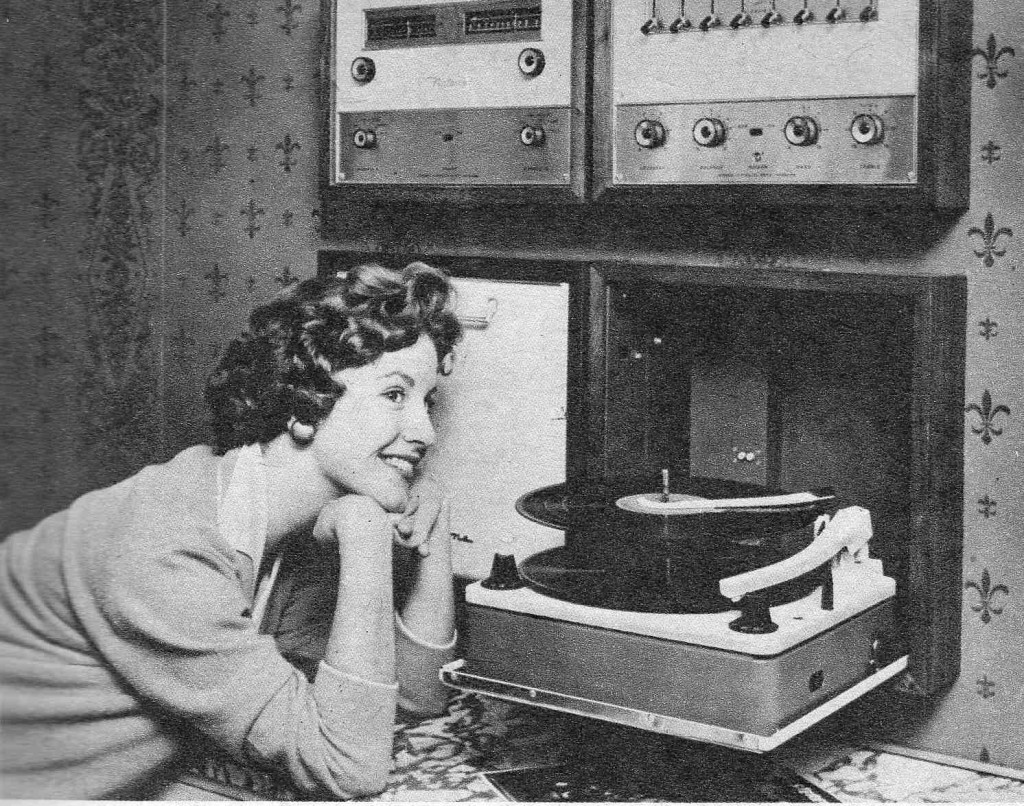
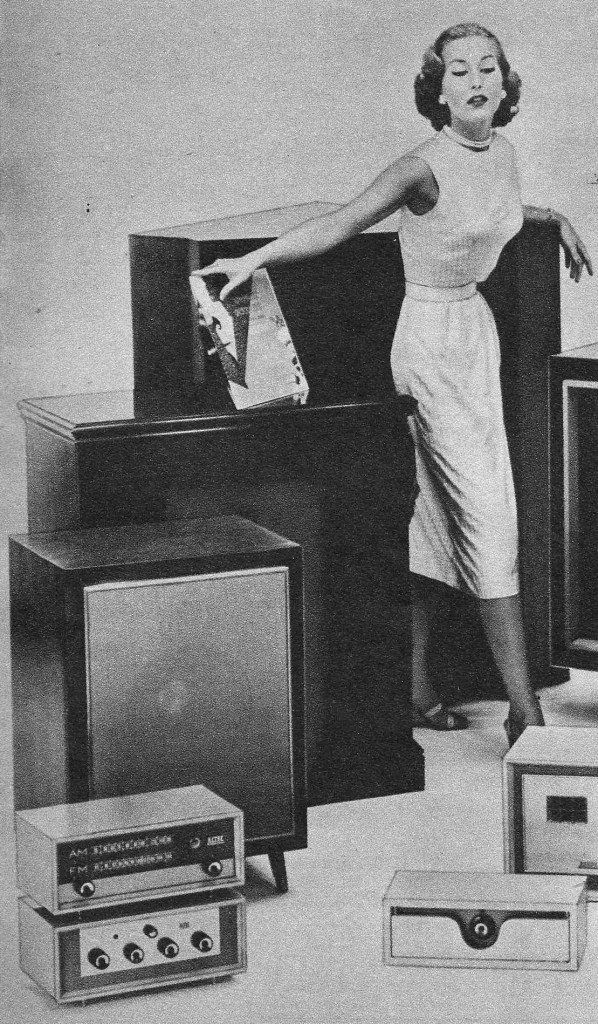
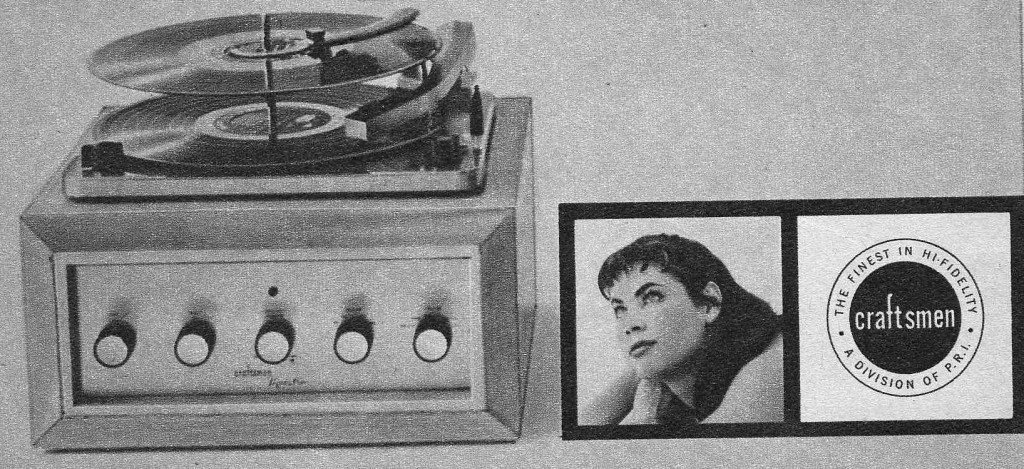
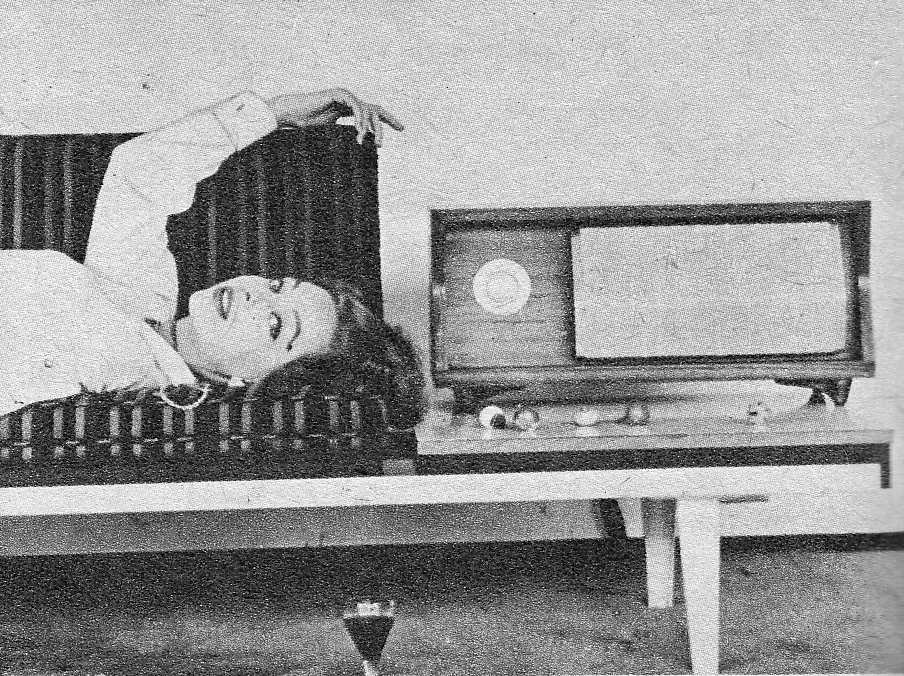 On rare occasion, we are shown women in more active (IE., less decor) roles. Here are a couple of examples: the (potential) technician and the shopper.
On rare occasion, we are shown women in more active (IE., less decor) roles. Here are a couple of examples: the (potential) technician and the shopper.
Electronic Drum Trends of the 1980s
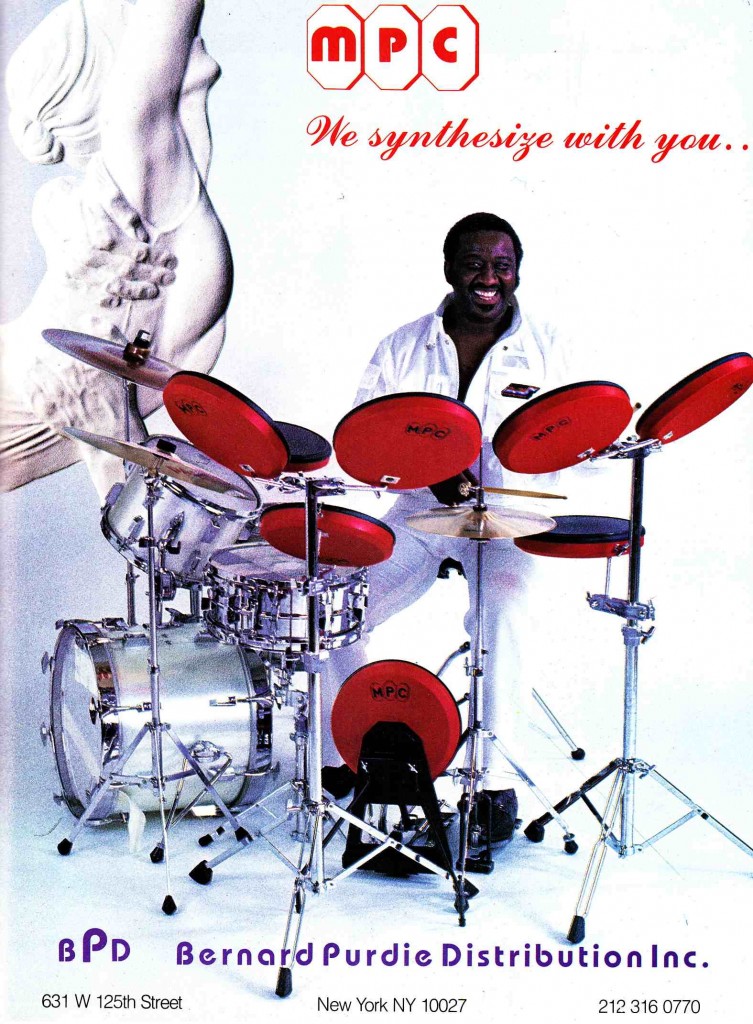 Legendary pop/RnB session drummer Bernard Purdie was apparently the distributor (!) of the MPC line of electronic drums. Purdie is best know for inventing the distinctive shuffle groove that would later appear in hits such as ‘Rosanna’ by the group Toto. He also replaced Pete Best’s drumming on an early US-market Beatles release. “But you wanna know something else?” This man loves life. Check it…
Legendary pop/RnB session drummer Bernard Purdie was apparently the distributor (!) of the MPC line of electronic drums. Purdie is best know for inventing the distinctive shuffle groove that would later appear in hits such as ‘Rosanna’ by the group Toto. He also replaced Pete Best’s drumming on an early US-market Beatles release. “But you wanna know something else?” This man loves life. Check it…
A few electronic-drumming odds and ends today from various issues of MUSICIAN magazine circa the mid 1980’s (see here for previous MUSICIAN mag coverage on PS dot com). Sampling drum machines, electronic drum kits, and live cymbal-effects processing were all new technologies at the time, and like all things 80s, they were delivered in a bright, bold, technology-YES manner. Put down that snare drum. Don’t be a square. Come on.
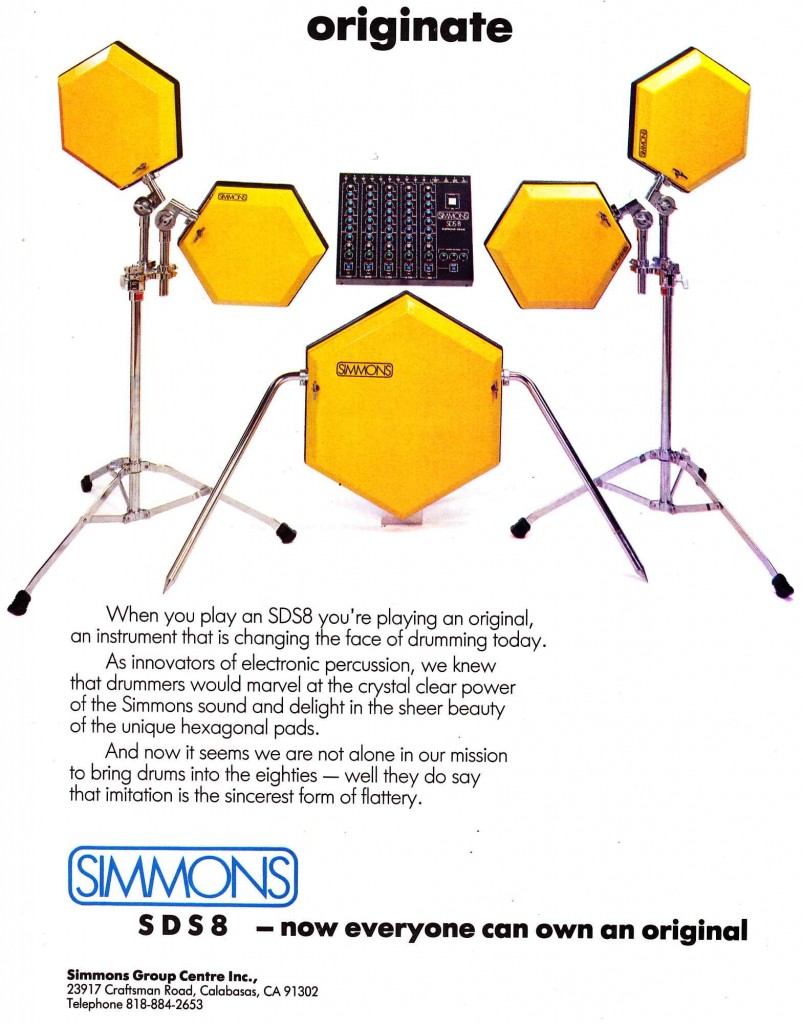 Simmons SDS8 electronic kit. “Our mission (is) to bring drums into the 80s.”
Simmons SDS8 electronic kit. “Our mission (is) to bring drums into the 80s.”
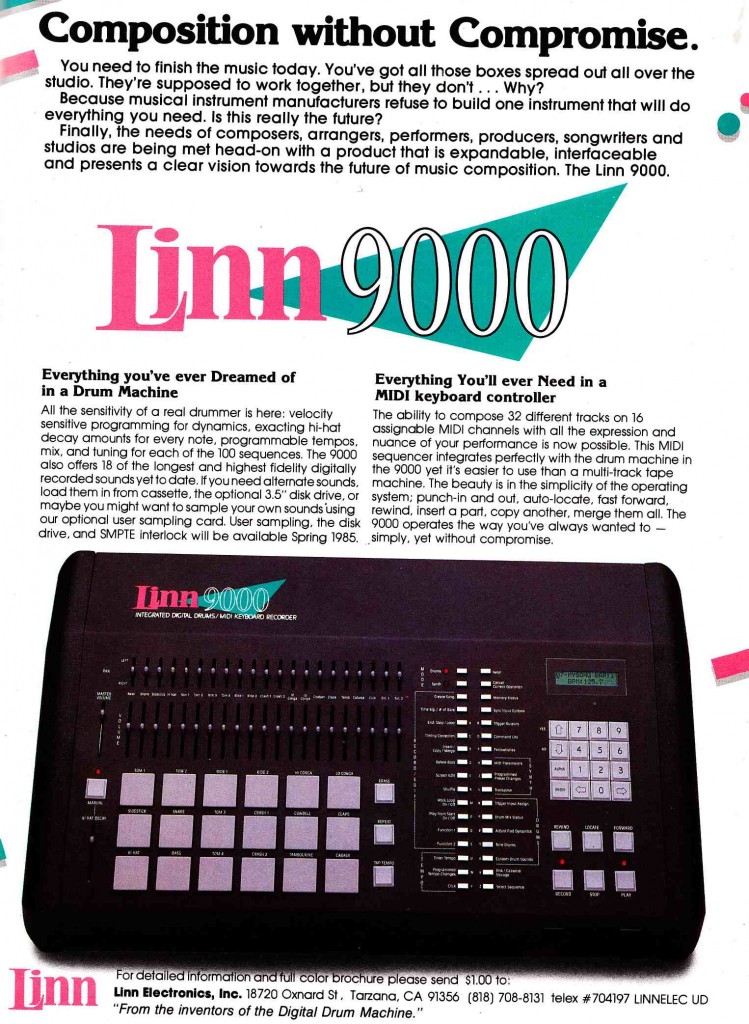 The Linn 9000 drum machine. Linn was the first company to make drum machines that played back ROM (read-only-memory) samples of actual recordings of acoustic drum hits rather than simply triggering analog synthesis circuits that made ‘drum sounds.’ By the 1990s you could not buy a new analog drum machine, and the ‘Rompler’ drum machine was industry standard, but Linn was a true innovator at the time and these things were crazy expensive, making them relatively uncommon today.
The Linn 9000 drum machine. Linn was the first company to make drum machines that played back ROM (read-only-memory) samples of actual recordings of acoustic drum hits rather than simply triggering analog synthesis circuits that made ‘drum sounds.’ By the 1990s you could not buy a new analog drum machine, and the ‘Rompler’ drum machine was industry standard, but Linn was a true innovator at the time and these things were crazy expensive, making them relatively uncommon today.
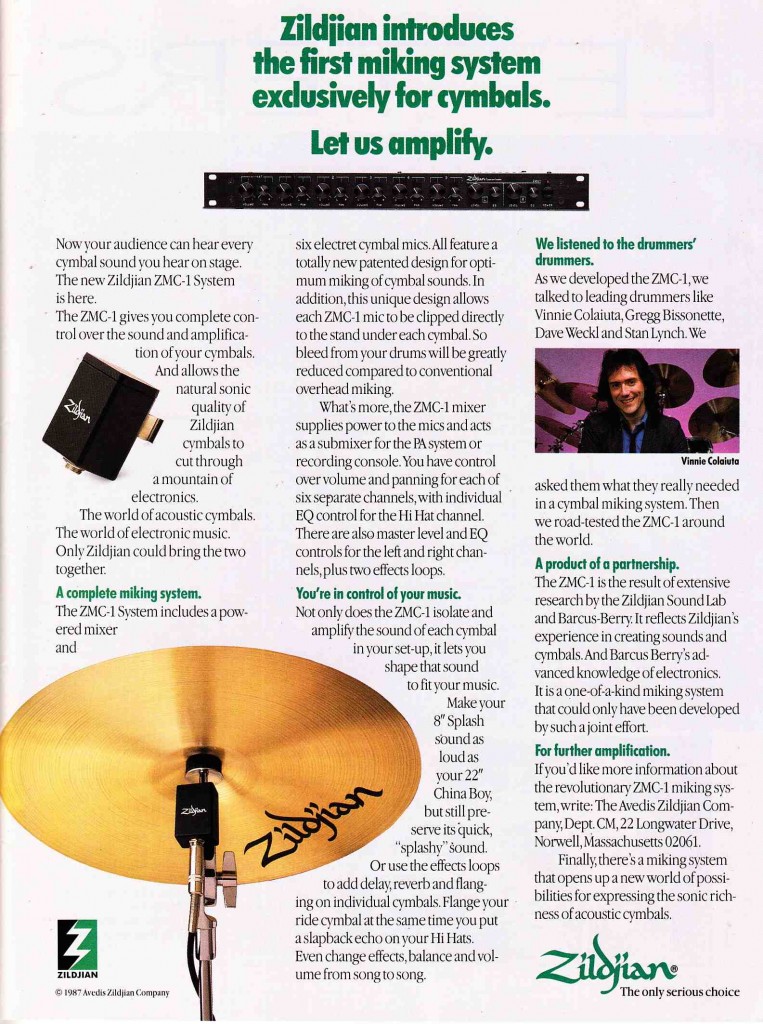 Zildjian cymbal miking system circa 1987. Let’s say you are a family who has been making cymbals for, oh, 400 years. All of sudden this new technology (sampling, synthesis) comes along which COULD make your product obsolete. Better get in the game, buddy. Basically a set of electret-condenser mics that clip to cymbal stands combined with a small mixer with effect loops. “Flange your ride cymbal at the same time you add a slapback echo on your hi hats.”
Zildjian cymbal miking system circa 1987. Let’s say you are a family who has been making cymbals for, oh, 400 years. All of sudden this new technology (sampling, synthesis) comes along which COULD make your product obsolete. Better get in the game, buddy. Basically a set of electret-condenser mics that clip to cymbal stands combined with a small mixer with effect loops. “Flange your ride cymbal at the same time you add a slapback echo on your hi hats.”
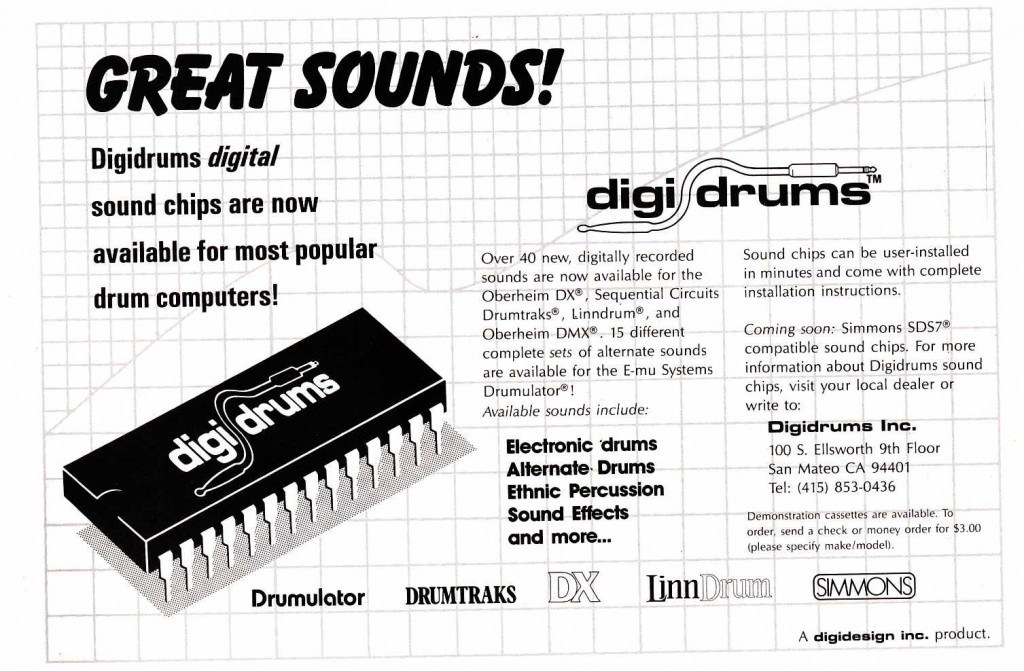 And in case you were wondering what Digidesign was doing prior to Changing-The-World with its Pro Tools digital audio recording/editing/mixing/processing software/hardware systems, well, here you have it. Digidesign presents: Digidrums! New ROM chips that you can stick inside your drum machine and get news sounds outta them! Make your drum machine sound more like real drums! And 18 years later Digidesign gives us…. Beat Detective! Make the drummer sound like a drum machine! Man vs Robot, the epic battle unfolds so slowly…
And in case you were wondering what Digidesign was doing prior to Changing-The-World with its Pro Tools digital audio recording/editing/mixing/processing software/hardware systems, well, here you have it. Digidesign presents: Digidrums! New ROM chips that you can stick inside your drum machine and get news sounds outta them! Make your drum machine sound more like real drums! And 18 years later Digidesign gives us…. Beat Detective! Make the drummer sound like a drum machine! Man vs Robot, the epic battle unfolds so slowly…
Meridan, Mississippi 1973
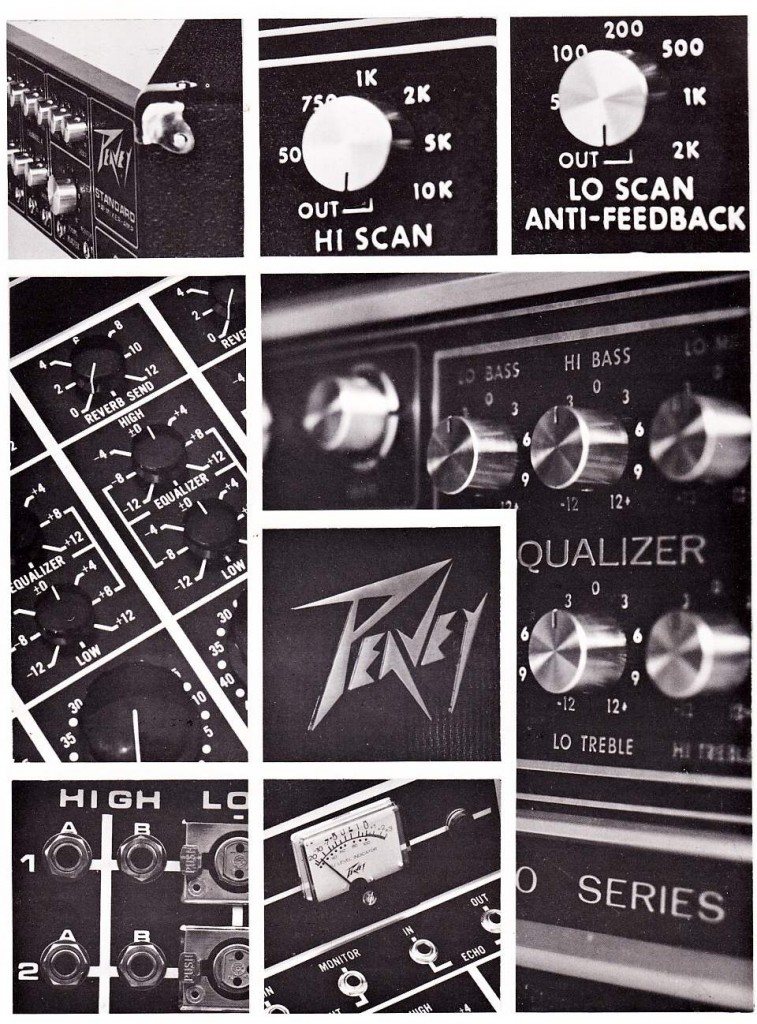 Download the twenty-four page 1973 Peavey Electronic Sound Equipment catalog:
Download the twenty-four page 1973 Peavey Electronic Sound Equipment catalog:
DOWNLOAD: Peavey_1973_catalog
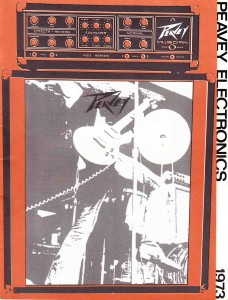 Products covered in this catalog include: Peavey Musician amplifier head; Peavey Bass amplifier head; Peavey F-800G and F-800B ‘festival’ high-power amplifier heads; VTA-400 tube amplifier head (with 4x 6550 power tubes); Peavey Vintage model 110 watt combo amp; Peavey Deuce 2×12 combo amp; Peavey Standard amplifier head; Peavey PA120, Standard PA, and PA 400 boxtop-style public-address mixer/amplifiers; Peavey PA-6A and PA-9 console-style PA mixer/amps; and a full range of speaker cabinets include the Peavey 115, 212, 215S, 215, 610, 412, 215H, 11bS, 612H, 118FH, and 412S cabinets.
Products covered in this catalog include: Peavey Musician amplifier head; Peavey Bass amplifier head; Peavey F-800G and F-800B ‘festival’ high-power amplifier heads; VTA-400 tube amplifier head (with 4x 6550 power tubes); Peavey Vintage model 110 watt combo amp; Peavey Deuce 2×12 combo amp; Peavey Standard amplifier head; Peavey PA120, Standard PA, and PA 400 boxtop-style public-address mixer/amplifiers; Peavey PA-6A and PA-9 console-style PA mixer/amps; and a full range of speaker cabinets include the Peavey 115, 212, 215S, 215, 610, 412, 215H, 11bS, 612H, 118FH, and 412S cabinets.
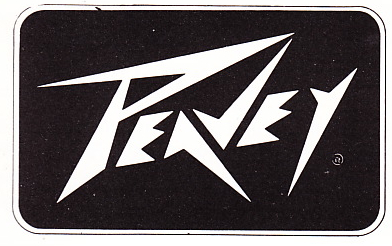 Oh that logo. So much has been said about that logo. Here it is, already firmly in place in 1973. It’s jagged, angular lines, amateurish lack of balance, and simple hi-con style seem to make it the granddaddy of all 1980s hair-metal graphic identities, and by extension, the graphic aesthetic of an entire youth subculture of the 1980s. Could this be? Or is it just a coincidence? Peavey did try a re-design in the 1990s, but came back to the ‘classic’ in short order.
Oh that logo. So much has been said about that logo. Here it is, already firmly in place in 1973. It’s jagged, angular lines, amateurish lack of balance, and simple hi-con style seem to make it the granddaddy of all 1980s hair-metal graphic identities, and by extension, the graphic aesthetic of an entire youth subculture of the 1980s. Could this be? Or is it just a coincidence? Peavey did try a re-design in the 1990s, but came back to the ‘classic’ in short order.
Has there ever been a more disliked logo in the very image-conscious world of popular music? Does Peavey (the company or the man) realize this? And do (they/he) give a fuck? Maybe that’s the answer itself. Considering that Peavey Electronics began as the basement-industry of a high school kid, a self-taught kid who by age 24 would have his own factory in Mississippi, and less than ten years later the owner of one of the largest audio manufacturers in America, at a time when so much of the American electronics industry had fled this country for Asian manufacture: I think it’s safe to assume that yes this is a confident, proud man who flies this awful logo as if to say: this is me. and yeah i can get away with it. My amps are still gonna sell. Semiotically it exists somewhere at the intersection of the Freak Flag/Pirate Flag/Confederate Flag/American Flag. Complicated anyhow. Oh let’s add Texas flag to that as well. ( I know that Peavey is not based in Texas but how many people have you seen with Mississippi tattoos if you catch my drift).
 Indeed. What is power. Is it an expression of man’s will to independence, his resiliency, his ability to triumph in the face of a difficult environment? Or is it simply his desire to dominate other men? It’s fascinating to note that in this lengthy catalog there are no guitar amplifers with less than 110 watts of power output. There are no amplifers with less than two twelve-inch speakers (or four ten-inch speakers). These are big amps. Only big amps. Peavey would eventually become (along with Crate) the standard-issue ‘small practice amp’ for kids and beginners in the 1980s, but there initial thrust was limited to these big, loud stage amps.
Indeed. What is power. Is it an expression of man’s will to independence, his resiliency, his ability to triumph in the face of a difficult environment? Or is it simply his desire to dominate other men? It’s fascinating to note that in this lengthy catalog there are no guitar amplifers with less than 110 watts of power output. There are no amplifers with less than two twelve-inch speakers (or four ten-inch speakers). These are big amps. Only big amps. Peavey would eventually become (along with Crate) the standard-issue ‘small practice amp’ for kids and beginners in the 1980s, but there initial thrust was limited to these big, loud stage amps.
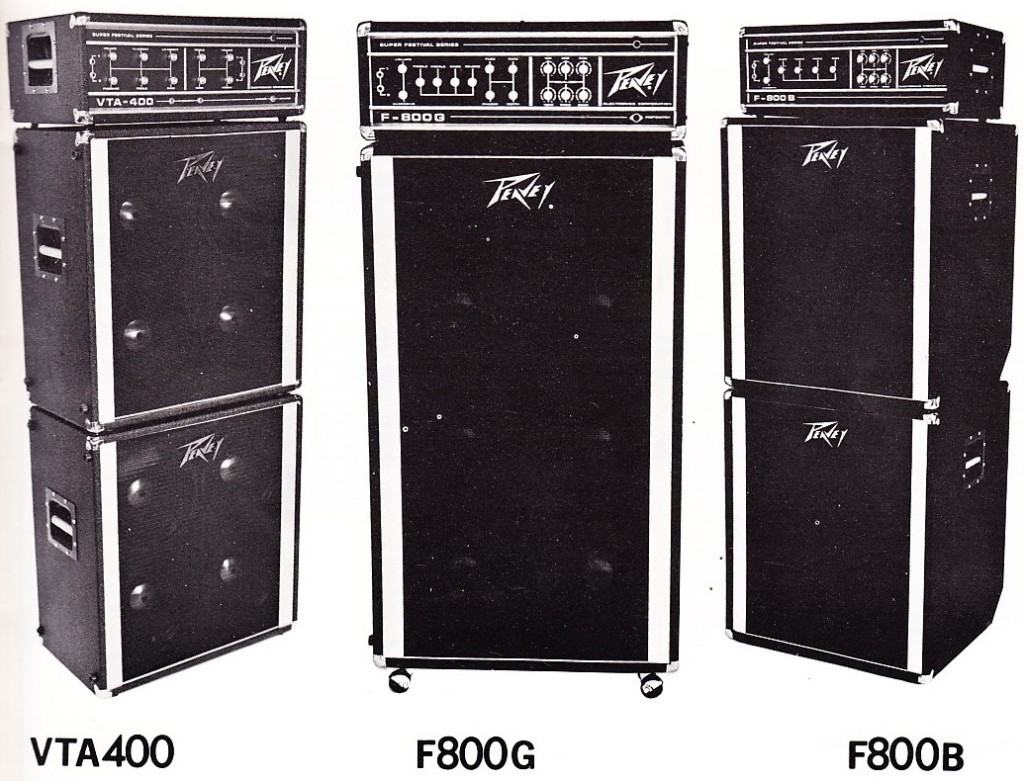 Above, the Peavey ‘Festival’ stacks of 1973. Tube-powered VTA400 at left, followed by the 4oo watt solid-state guitar and bass versions. I’ve owned and used several Peavey amps, but I have never plugged into a Festival. I will say this, based on my limited experience with Peavey amps: the solid-state circa 1985 Bandit 65 that I briefly used in high school was the the best-sounding solid state guitar amp that I have ever used. The distortion character was incredibly tube-like; really uncanny (my other amp at the time was an all-tube Fender Champ 12, so I did have some limited frame of reference). I later had one of those 2×12 dual-6L6/solid-state preamp combos from the 1970s; it sounded great in the room, probably due to the open-backed cabinet, but always fell short when close-mic’d.
Above, the Peavey ‘Festival’ stacks of 1973. Tube-powered VTA400 at left, followed by the 4oo watt solid-state guitar and bass versions. I’ve owned and used several Peavey amps, but I have never plugged into a Festival. I will say this, based on my limited experience with Peavey amps: the solid-state circa 1985 Bandit 65 that I briefly used in high school was the the best-sounding solid state guitar amp that I have ever used. The distortion character was incredibly tube-like; really uncanny (my other amp at the time was an all-tube Fender Champ 12, so I did have some limited frame of reference). I later had one of those 2×12 dual-6L6/solid-state preamp combos from the 1970s; it sounded great in the room, probably due to the open-backed cabinet, but always fell short when close-mic’d.
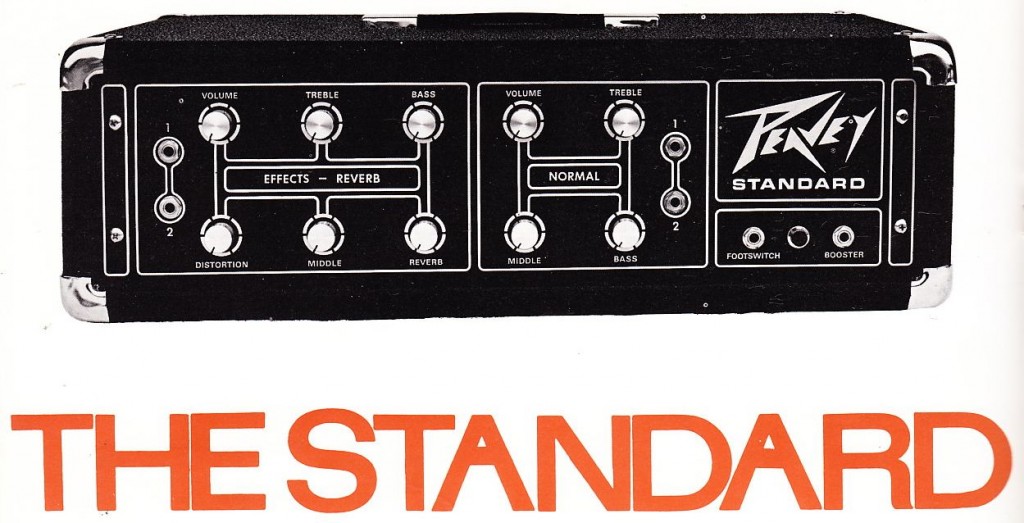 Lately I’ve been noticing that folks are trying to get in the area of $400 for these old Peavey stacks; this is much more money that they were ten years ago, so I suppose the ‘vintage’ tag is getting attached to them finally. I’m not sure if anyone’s buying them; I don’t see as many bands live in clubs as I used to; if you’re a young band who has chosen to rock an old Peavey solid-state stack over a (vintage or modern) tube amp, drop us a line and let us know why. There’s nothing inherently better or worse about solid-state or tube amps; it’s purely a preference, a matter of aesthetics; the balance of favor has been with tubes for the past twenty years but that could certainly change someday.
Lately I’ve been noticing that folks are trying to get in the area of $400 for these old Peavey stacks; this is much more money that they were ten years ago, so I suppose the ‘vintage’ tag is getting attached to them finally. I’m not sure if anyone’s buying them; I don’t see as many bands live in clubs as I used to; if you’re a young band who has chosen to rock an old Peavey solid-state stack over a (vintage or modern) tube amp, drop us a line and let us know why. There’s nothing inherently better or worse about solid-state or tube amps; it’s purely a preference, a matter of aesthetics; the balance of favor has been with tubes for the past twenty years but that could certainly change someday.
Kay Electric Guitars c. 1968
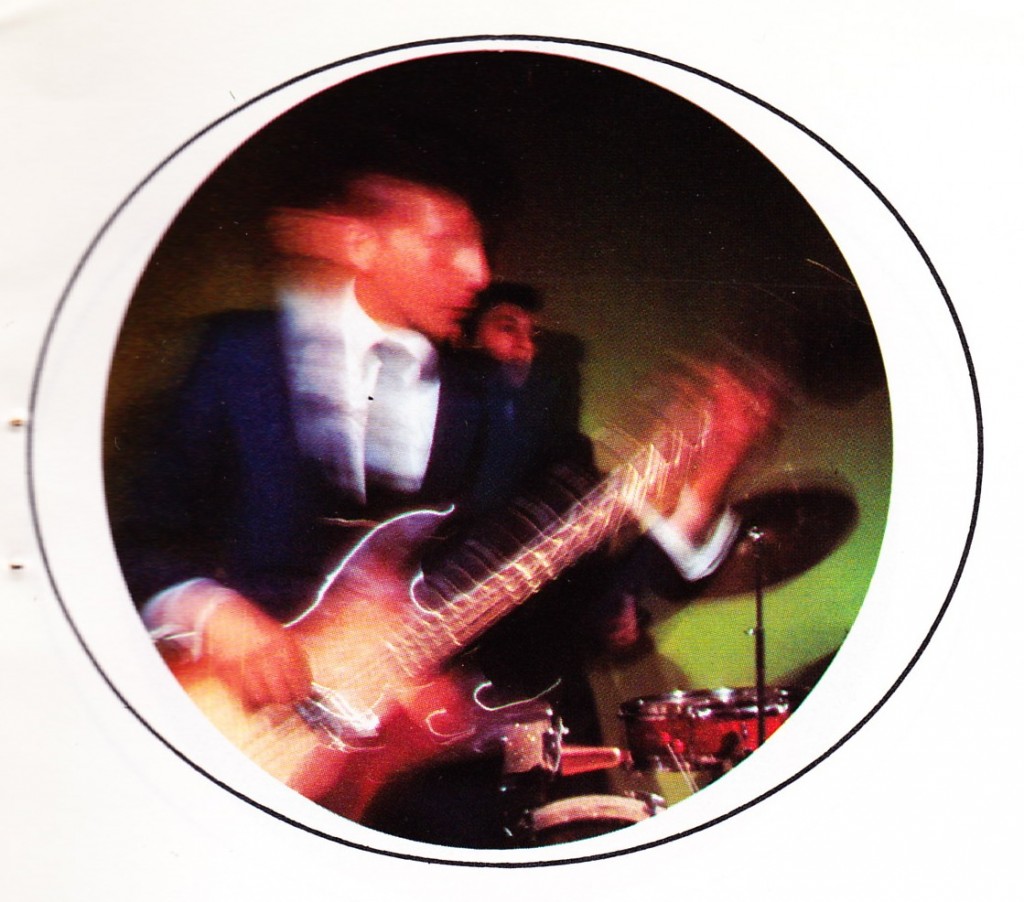 Goddamn I am playing this bass real fast
Goddamn I am playing this bass real fast
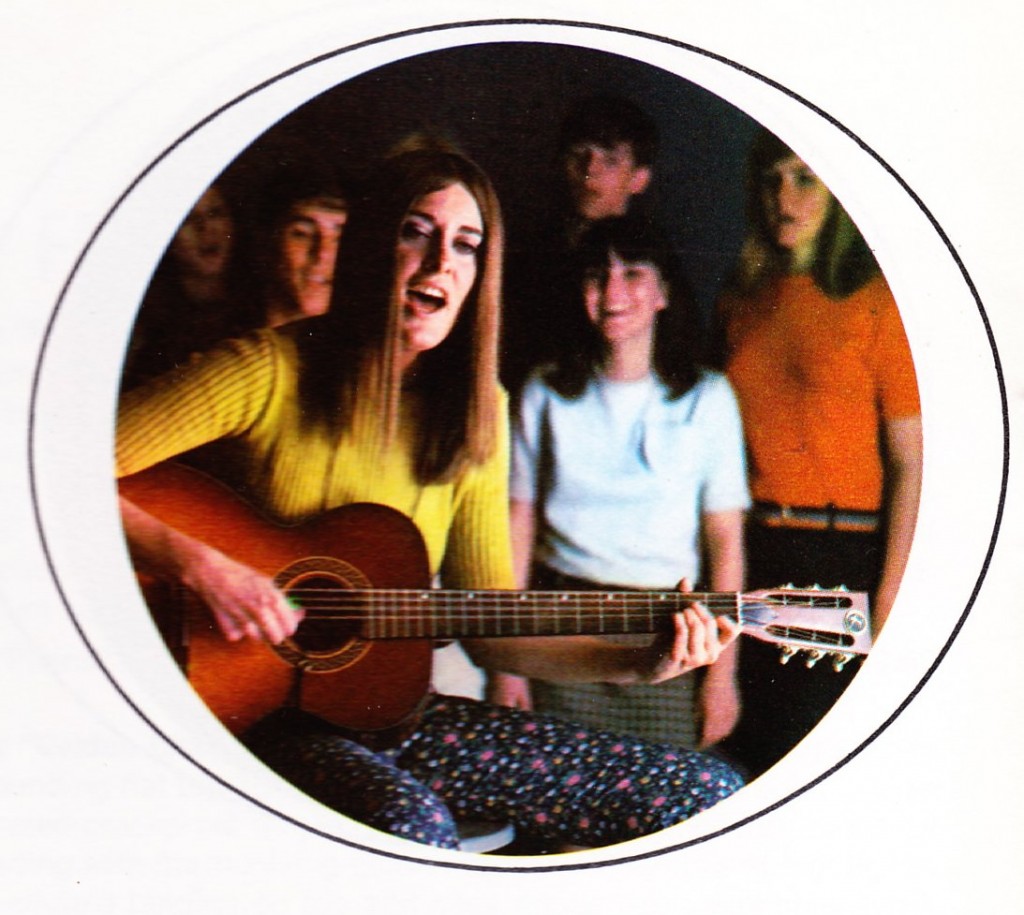 My mom didn’t like her, but Ms Friedman was totally the best teacher
My mom didn’t like her, but Ms Friedman was totally the best teacher
***************
*******
***
Download fourteen pages of electric guitars and amplifiers from the Kay Instrument catalog circa 1968:
DOWNLOAD: Kay_Elec_Gtrs_Amps_1968
Models on offer include: Kay K400, K401, K402, K403, K404, K405, K406, and K407 K400 series “Professional” deluxe solidbody electric guitars w/ vibrato; K365 Apollo II guitar; K370 top-end “Artist” guitar, K355 Titan II; Kay K326, K327, and K328 Vanguard II guitars; K 310, 311, and 312 Value Leader guitars; Kay K318 and 319 Speed Demon guitars; Kay K561, 562m 563, K6530, K585, K625, K6262, K659, K651, K682, and K683 hollowbody electric guitars; K5951, K5952, K 5921, K5922, K5923, K5924, K5925, K5926, K5935, K5917, K5918, and K5919 electric bass guitars; and a whole slew of forgettable solid-state amplifiers.
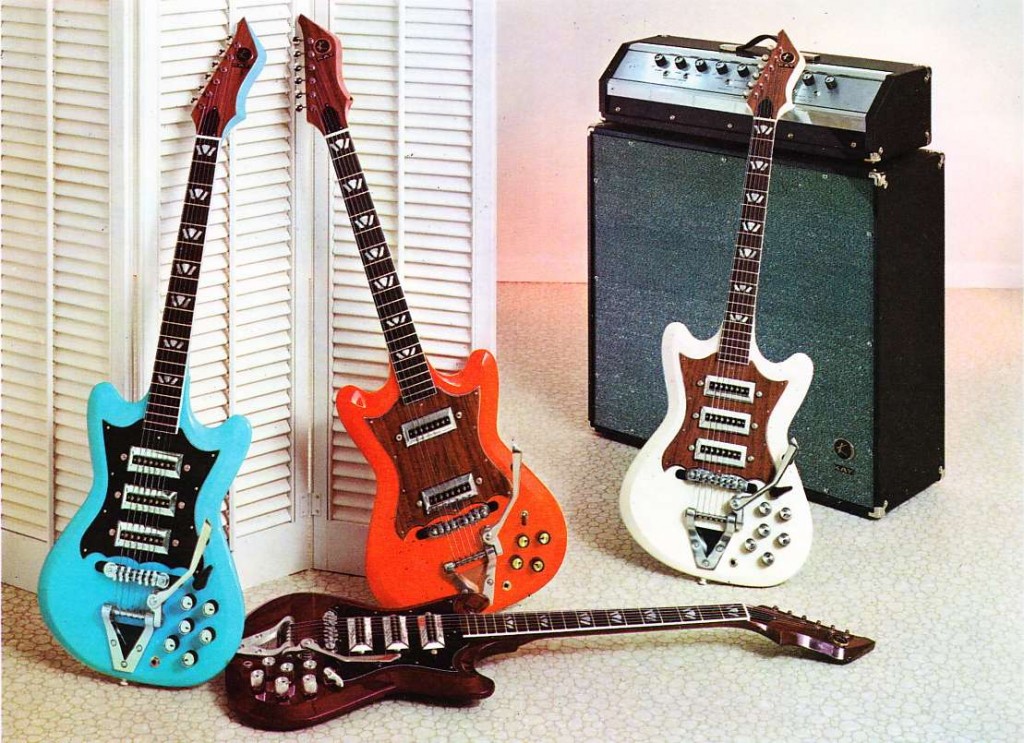 Kay Instruments (by this point, a division of the Seeburg Jukebox company) was, along with Harmony, one of the Chicagoland giants of mass-manufacture of musical instruments in America throughout much of the twentieth century. Their guitars tended to by a little flashier and a little worse-playing than those made by Harmony, but there are of course some notable exceptions. The late-60’s Kays in this catalog are some of the last American-built Kay-branded instruments to be sold, and they are not among the more collectible of the Kay oeuvre (for that, see for example the Kay Jazz II). Many of the instruments in this catalog are pretty common, the exceptions being the higher-priced 400 series and the kinda outrageously expensive K370. Anyone out there ever owned one of these?
Kay Instruments (by this point, a division of the Seeburg Jukebox company) was, along with Harmony, one of the Chicagoland giants of mass-manufacture of musical instruments in America throughout much of the twentieth century. Their guitars tended to by a little flashier and a little worse-playing than those made by Harmony, but there are of course some notable exceptions. The late-60’s Kays in this catalog are some of the last American-built Kay-branded instruments to be sold, and they are not among the more collectible of the Kay oeuvre (for that, see for example the Kay Jazz II). Many of the instruments in this catalog are pretty common, the exceptions being the higher-priced 400 series and the kinda outrageously expensive K370. Anyone out there ever owned one of these?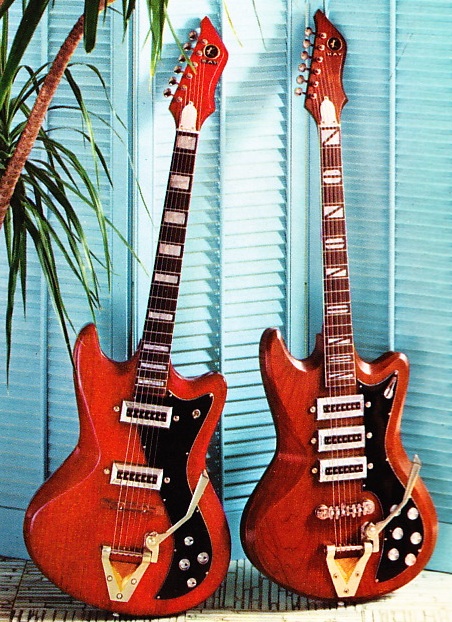
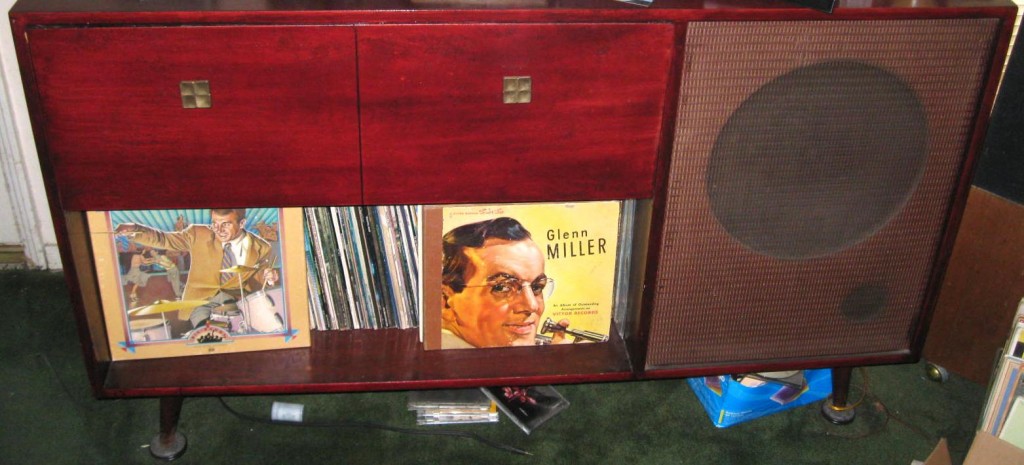 From PS Dot Com reader C. McColm come these images of his original circa 1955 Pilot mono hi-fi system. I take C.M. at his word when he relates that there was a cult for Pilot in the 1950s; this website gets an unusual amount of traffic from individuals searching for, and reading, the few PILOT articles I have posted.
From PS Dot Com reader C. McColm come these images of his original circa 1955 Pilot mono hi-fi system. I take C.M. at his word when he relates that there was a cult for Pilot in the 1950s; this website gets an unusual amount of traffic from individuals searching for, and reading, the few PILOT articles I have posted.
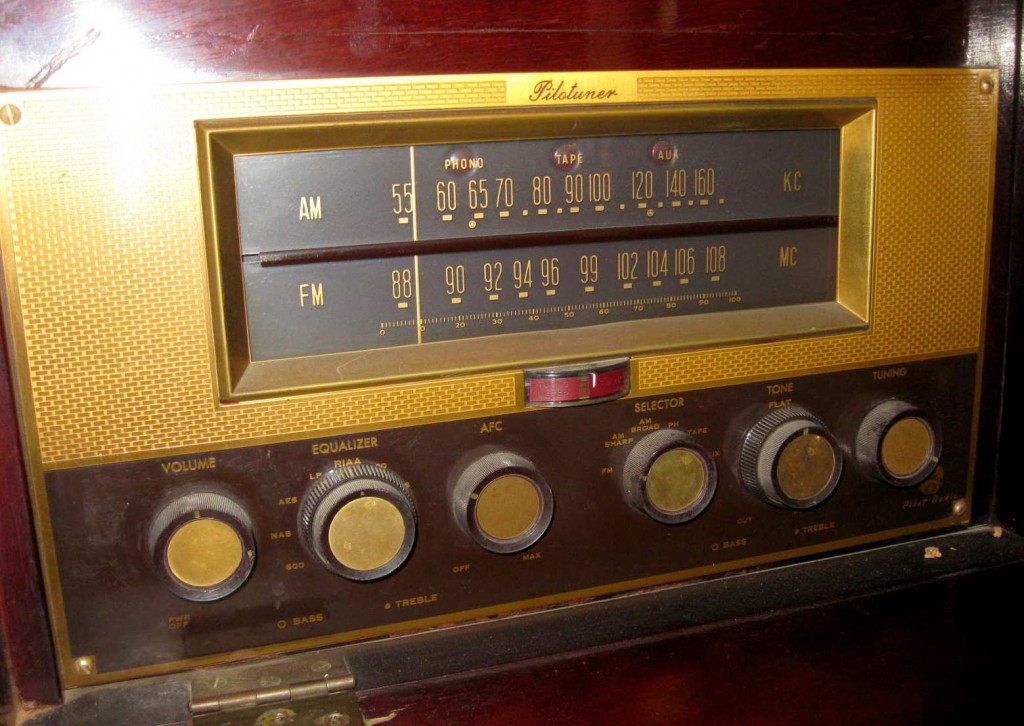 Pilotuners were made for a very long time, in many configurations; I’ve personally bought two in the past year alone. Complete 1950s hi-fi systems like C.M.s are rare these days for many reasons, not the least of which is the fact that many have been cut up and gutted for parts over the years. It can be hard to find the space to incorporate a unit like this in a modern domestic-space, but for anyone who enjoys listening to 1940s and 1950s recordings, I can’t imagine a better way to hear it than on a system like this.
Pilotuners were made for a very long time, in many configurations; I’ve personally bought two in the past year alone. Complete 1950s hi-fi systems like C.M.s are rare these days for many reasons, not the least of which is the fact that many have been cut up and gutted for parts over the years. It can be hard to find the space to incorporate a unit like this in a modern domestic-space, but for anyone who enjoys listening to 1940s and 1950s recordings, I can’t imagine a better way to hear it than on a system like this.
C.M. relates:
‘ALL PILOT electronics; Pilotuner tuner/pre amp, Miracord Auto Turntable. Williamson Amp with a pair of Genelex KT66 tubes … Great sound: like you are really there. The Pilot pre amp tuner has adjustable AFC for the FM, EQ for the phono; roll-off and turnover frequencies and a setting for early 78s; if you have 78’s, you need this eq setting to hear them properly. The built-in speaker cabinet is ported and bass reproduction is clear and solid. The High end on the triaxial speaker is great also. Speaker is branded University Sound; (this was) a division of Altec. Huge speaker with L-pads for the mid and high frequency drivers.
‘ This console, with the original Goodmans Speaker, won 1st place in a hi-fi show in NY city. My friend’s Father assembled it .This turntable has a Magnetic cartridge . A lot of systems then were (considered) hi-end if they had a Magnetic phono input . It has both LP and 78 needles switch-able without removal.’
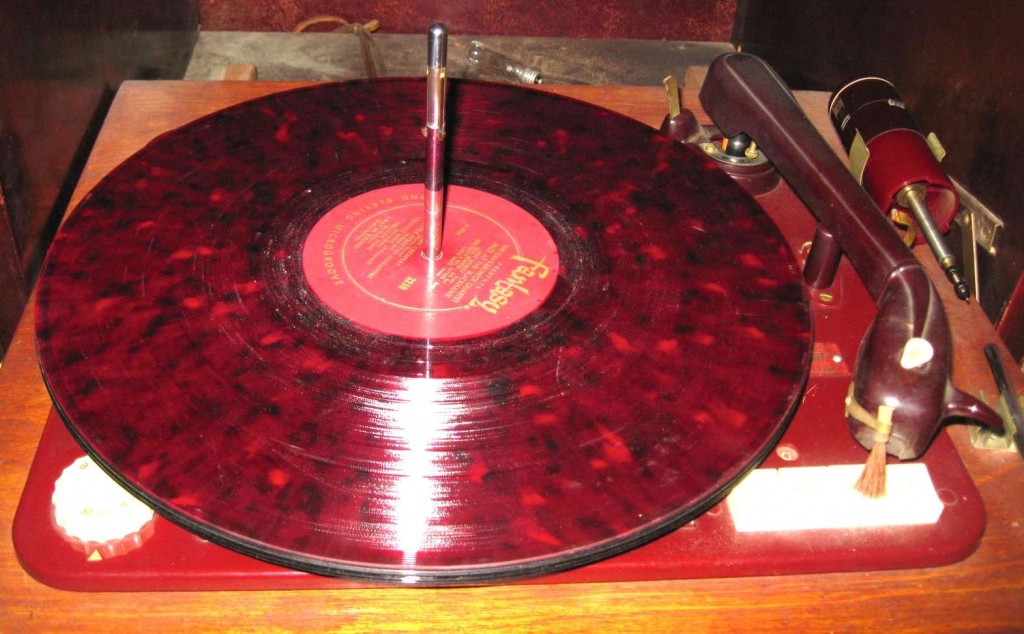 ‘This set sat inoperative for a long time . (I performed) a complete cabinet restoration, replaced a fuse, and cleaned the controls. This set really gets the job done. Pilot was really HI END; it was not as popular as Fisher or Marantz or Scott. People in the know knew about this stuff.’
‘This set sat inoperative for a long time . (I performed) a complete cabinet restoration, replaced a fuse, and cleaned the controls. This set really gets the job done. Pilot was really HI END; it was not as popular as Fisher or Marantz or Scott. People in the know knew about this stuff.’
See this link and this link for previous PILOT coverage on Preservation Sound.
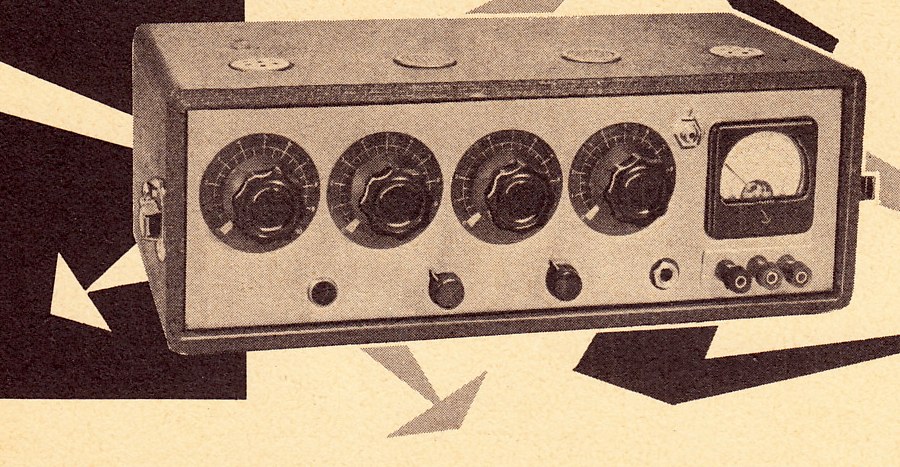 Download a three-page article from Electronics World “Hi Fi Annual & Audio Handbook 1960” which details the construction of a 4-channel tube mixer:
Download a three-page article from Electronics World “Hi Fi Annual & Audio Handbook 1960” which details the construction of a 4-channel tube mixer:
DOWNLOAD: Tube_Mix_It_Box_1960
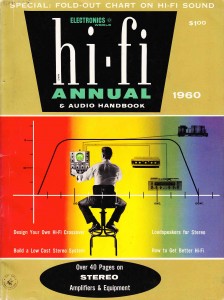 “Electronics World” Magazine published these ‘hi-fi annuals’ in the late 50s/early 60s; from what i can gather, they seem to be collections of reprints of the notable audio-content that EW published in the prior year. I picked up this 1960 edition a few years ago in the excellent Antiques Mall of Madison; some excellent vinyl LPs and rare paper dealers as well.
“Electronics World” Magazine published these ‘hi-fi annuals’ in the late 50s/early 60s; from what i can gather, they seem to be collections of reprints of the notable audio-content that EW published in the prior year. I picked up this 1960 edition a few years ago in the excellent Antiques Mall of Madison; some excellent vinyl LPs and rare paper dealers as well.
Anyhow. This mixer has some interesting features; nice simple circuit for calibration pot for DB meter; the best part though is the output stage: a 6AK6 tube is used into a 10k ohm load and promises a .8 watt output. I am not aware of any other hi-fi line output stages with 6AK6s; def want to try it. .8 watts output would very welcome in many of my builds… can’t get enough of that clean headroom…
Here’s the schematic (included in the download as well).
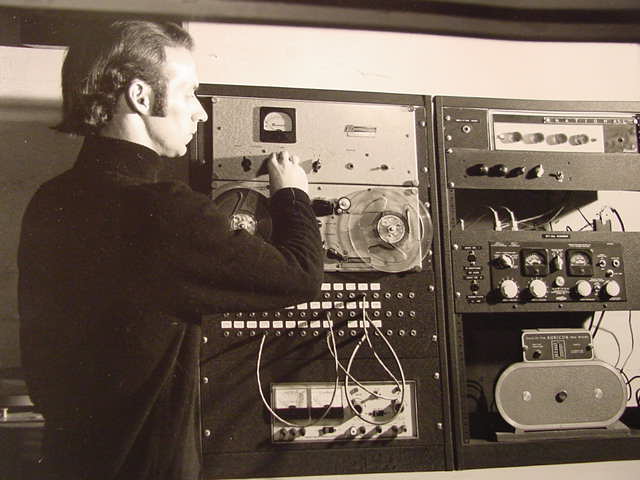 Trolling eBay today in the wake of ‘tropical storm’ irene… came across this very serious-looking gentleman at-work with a pretty serious film-sound (dubbing? editing) setup crica 1955. Most of the equipment in this picture is on sale right now on eBay; follow this link.
Trolling eBay today in the wake of ‘tropical storm’ irene… came across this very serious-looking gentleman at-work with a pretty serious film-sound (dubbing? editing) setup crica 1955. Most of the equipment in this picture is on sale right now on eBay; follow this link.
There’s a chance that Gold Coast Recorders will soon have a Crumar DS-2 in our synth collection/pile; researching this Italo-Moog turned up the absolute best instrument-demonstration video that I have ever seen on youtube. As Polish creator WC Olo Garb states, his (?) mission is to “show() you not what a synthesizer can do, but what a man can do with a synthesizer.” For instance:
All in all, the video provides some of the best video-treatment analogies-to-sonic-effects that I’ve ever seen. The filtering, jump cuts, found footage, multiple flavors of distressing, even the wardrobe choice are all incredibly incisive. Even with the sound turned off I think you could get a sense of the Crumar DS-2. Well worth all 11 minutes of your Thursday.
Download a thirteen-page excerpt from “The Guitars Friend” (no author credited), Quick Fox publishers, ISBN# 0-8256-3072-X:
DOWNLOAD: GuitarsFriend_Elec
Billed alternately as a ‘Catalog’ and a ‘Guide,’ “The Guitars Friend” (h.f. “TGF”) is a charming artifact of the late-hippie-era. From the self-description offered in the book, TGF began as a mail-order catalog begun by former (owners or employees – unclear) of ‘Music, Strings, and Things’ a Detroit-area music store. Seems that these retailers wanted to move to the country, and they took their business with them. A few years later, they had stopped the mail-order business and took to solely publishing this guidebook to current musical instruments. We’re not trying to sell you anything, man. Just sharing. (Although they apparently will sell you much of the gear if you write to them? it’s all very vague.) Check it out in their own words:
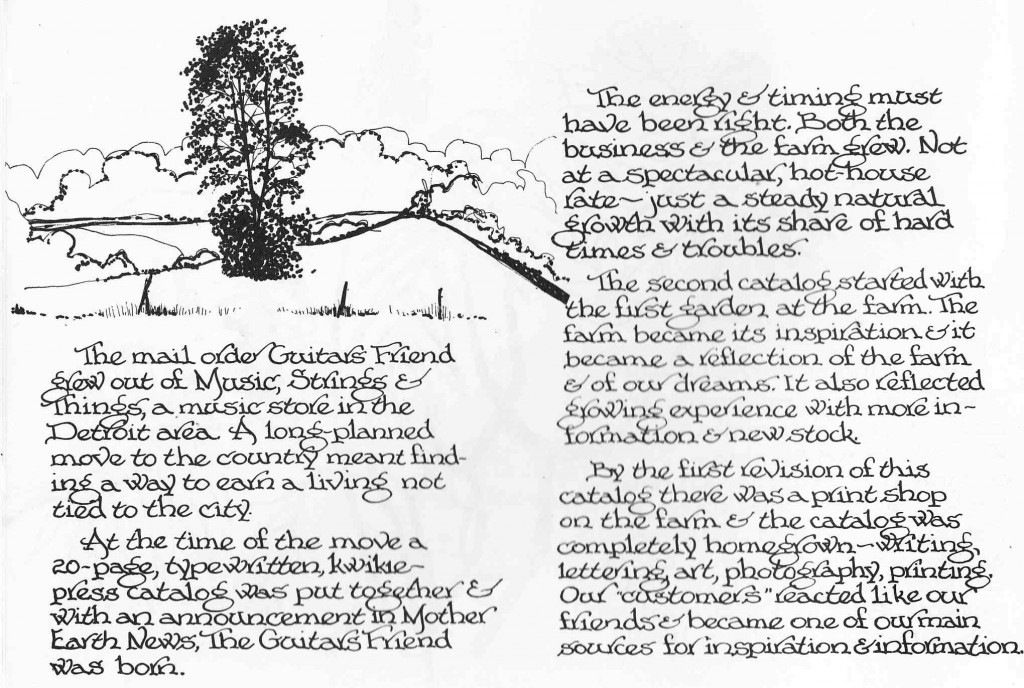 The entire 180-pp volume is entirely hand-lettered and largely hand-illustrated. It’s a pretty fantastic relic of the post-woodstock-youth generation as well as the back-to-the-land movement.
The entire 180-pp volume is entirely hand-lettered and largely hand-illustrated. It’s a pretty fantastic relic of the post-woodstock-youth generation as well as the back-to-the-land movement.
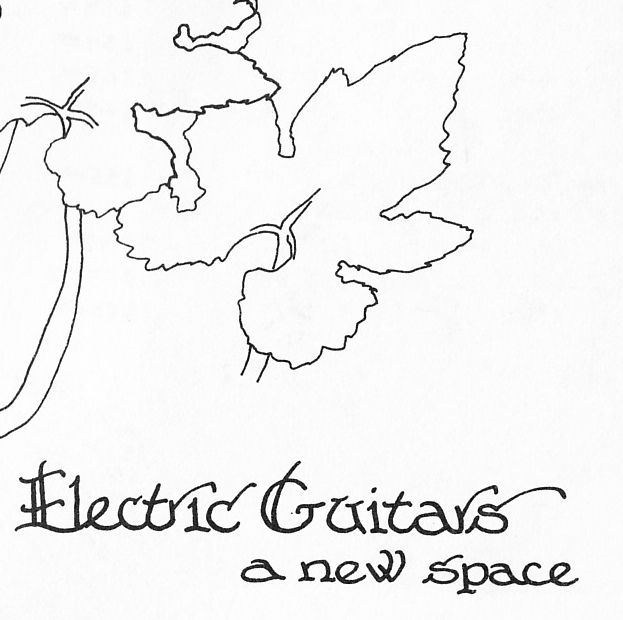 The book features descriptions and advice concerning mainly acoustic instruments, but there is a good ten pages devoted to electric guitars (no mention of amps and effects). I’ve included the electric bits in their entirety in the download link at the head of this article. Guitars depicted and discussed include: Ibanez Firebrand, Rocket Roll, MoonLight 59, F.M. Jr, Howie Roberts, Rick Bass, Old-Style Strat, and Strato Model; Gibson Les Paul Custom, Les Paul Deluxe, ES 335, SG Custom, Standard, L6S, and the Gibson Ripper and Grabber Bass; Fender Stratocaster, Telecaster, Mustang, Precision, Jazz, and Mustang Bass (es); Rickenbacker 4001; The Seagull Guitar, described as being built by Bernardo Rico (better known in the 80s as B.C. Rich);The Travis Bean TB1000 Standard and Deluxe; The Sunrise Electric Guitar (no model name given; made in Kalamazoo MI); and finally the Alembic Long Scale Bass and guitar, a steal at $1750 (that’s $6200 dollars in today’s bread).
The book features descriptions and advice concerning mainly acoustic instruments, but there is a good ten pages devoted to electric guitars (no mention of amps and effects). I’ve included the electric bits in their entirety in the download link at the head of this article. Guitars depicted and discussed include: Ibanez Firebrand, Rocket Roll, MoonLight 59, F.M. Jr, Howie Roberts, Rick Bass, Old-Style Strat, and Strato Model; Gibson Les Paul Custom, Les Paul Deluxe, ES 335, SG Custom, Standard, L6S, and the Gibson Ripper and Grabber Bass; Fender Stratocaster, Telecaster, Mustang, Precision, Jazz, and Mustang Bass (es); Rickenbacker 4001; The Seagull Guitar, described as being built by Bernardo Rico (better known in the 80s as B.C. Rich);The Travis Bean TB1000 Standard and Deluxe; The Sunrise Electric Guitar (no model name given; made in Kalamazoo MI); and finally the Alembic Long Scale Bass and guitar, a steal at $1750 (that’s $6200 dollars in today’s bread).
Anyhow. DL the file and give it a look… some of the writing is pretty amazing; as in the discussion of Ibanez, who were then churning out thousands of what we now term ‘lawsuit guitars’:
“The Ibanez people…can make a copy of almost any stringed instrument and make it as good but cheaper than the original…The only complaint people seem to have is status-wise – that it is a Japanese copy. Once they get past their own ego and conditioning, they are amazed at the quality.”
Let go of yr hangups and order a copy of “The Guitars Friend.” Four currently available on Amazon dot com.
